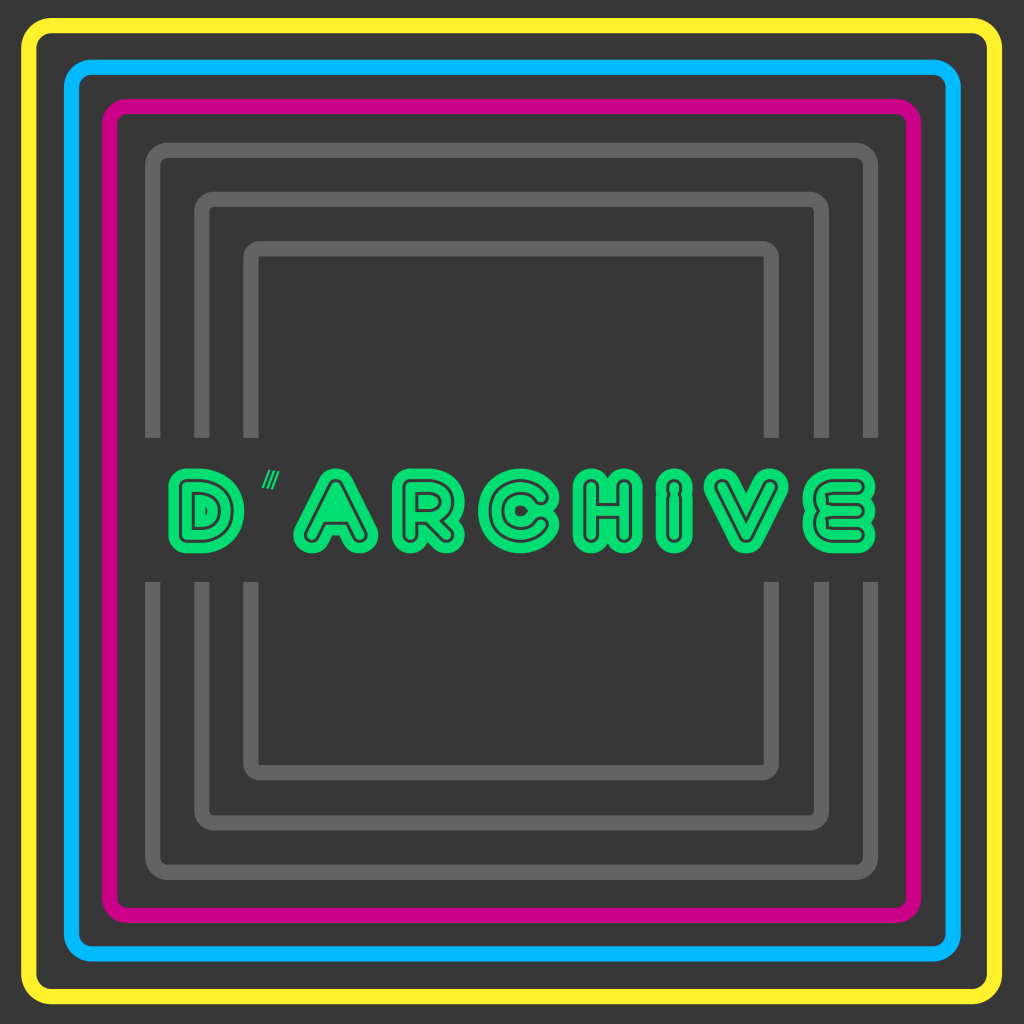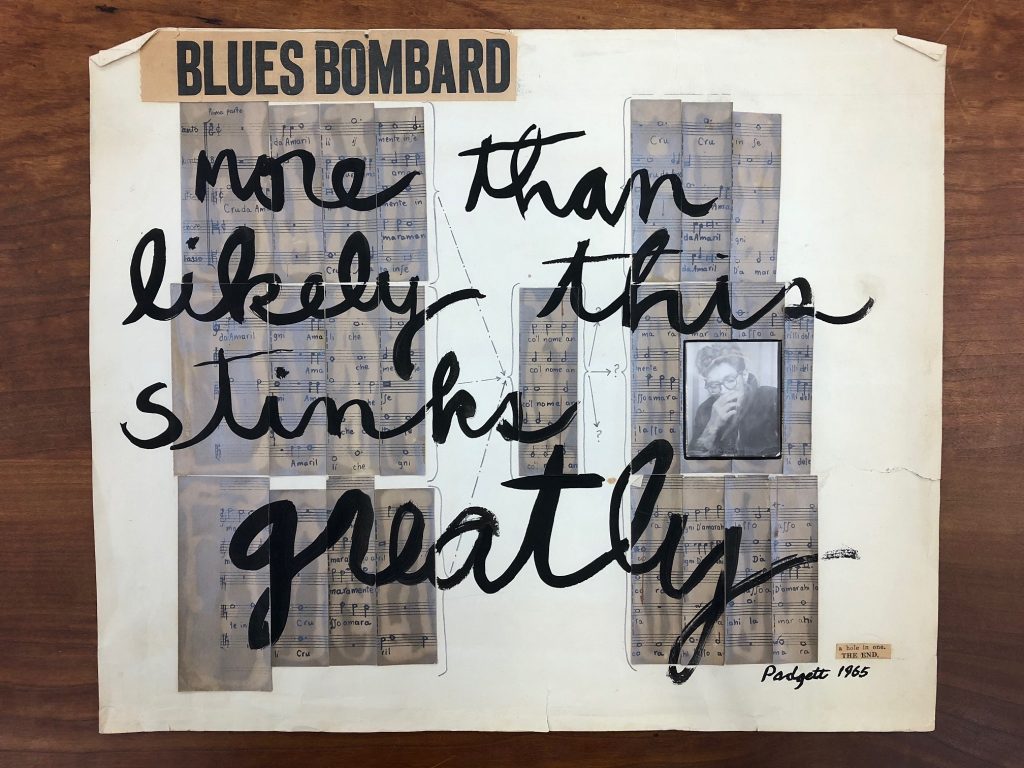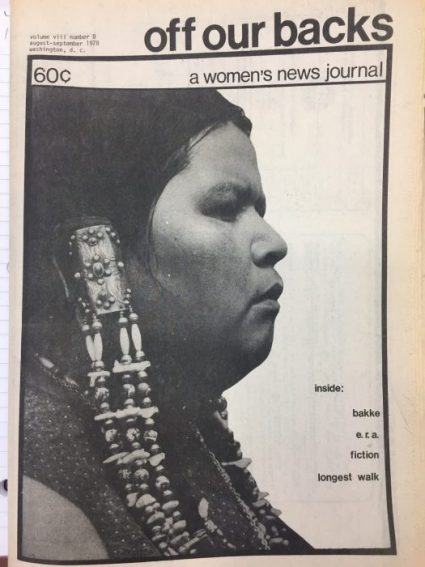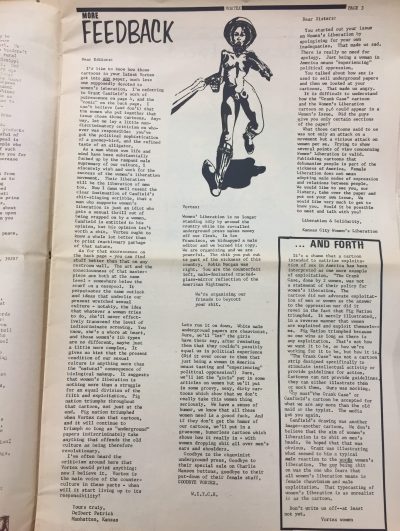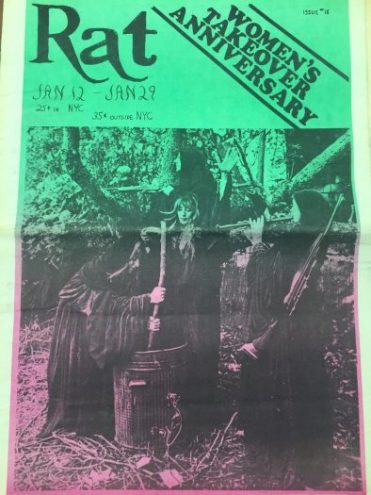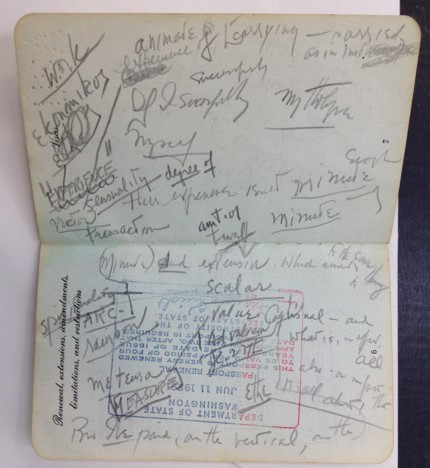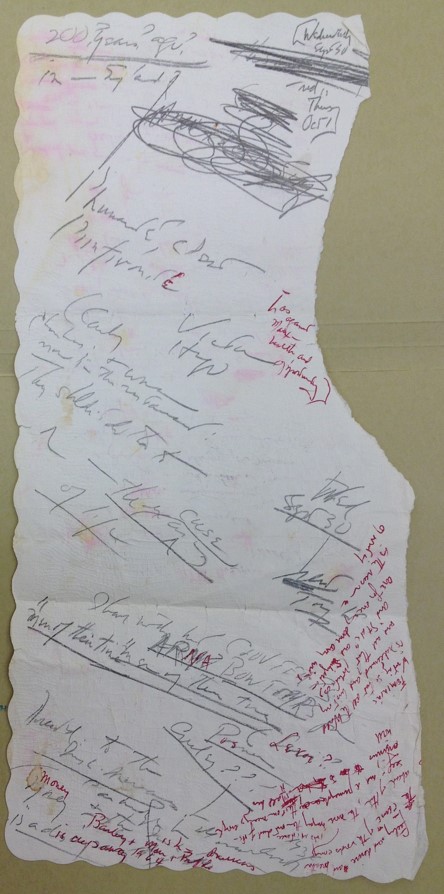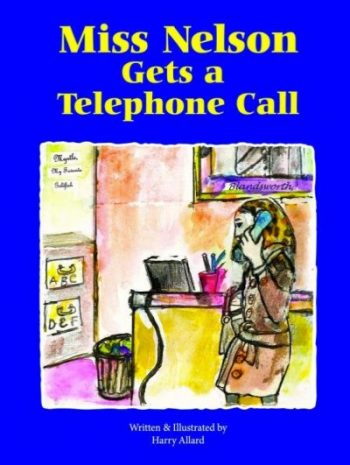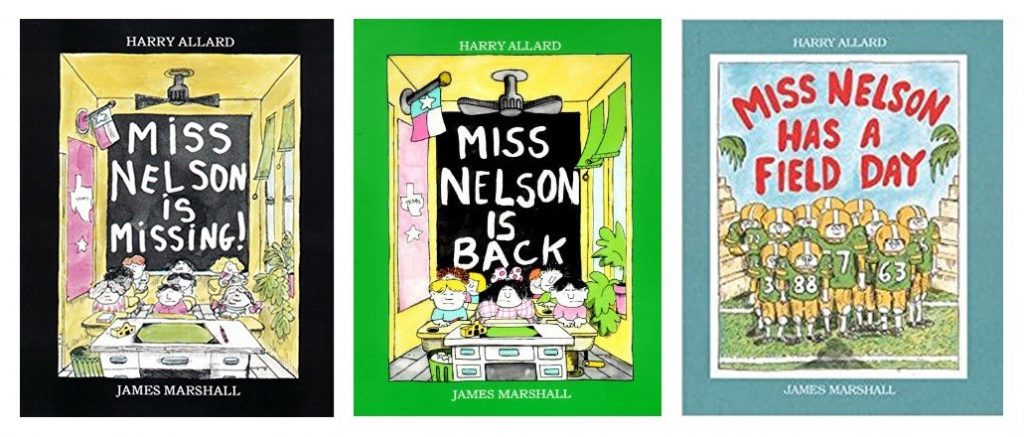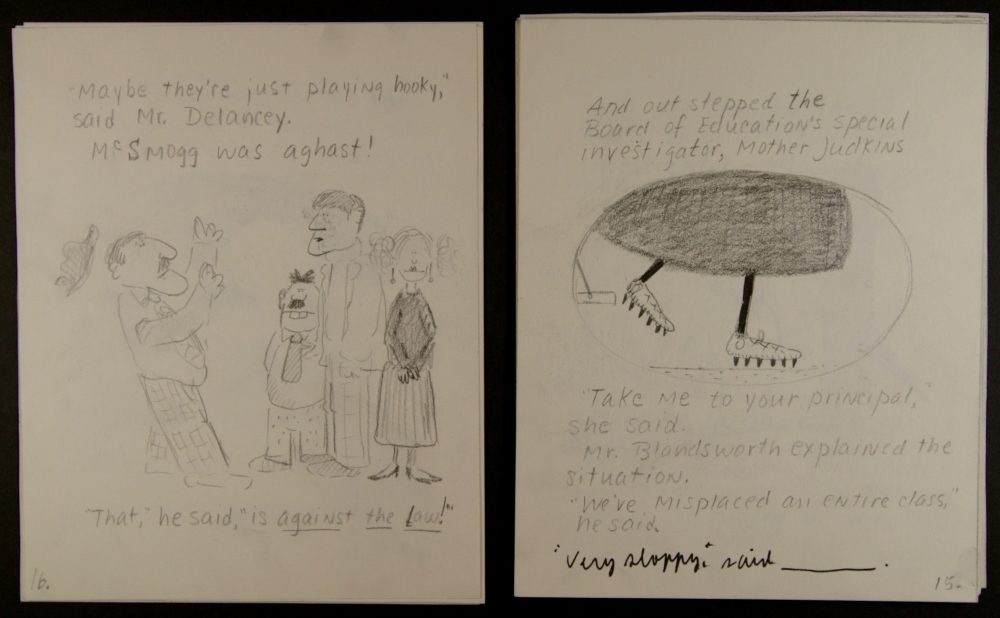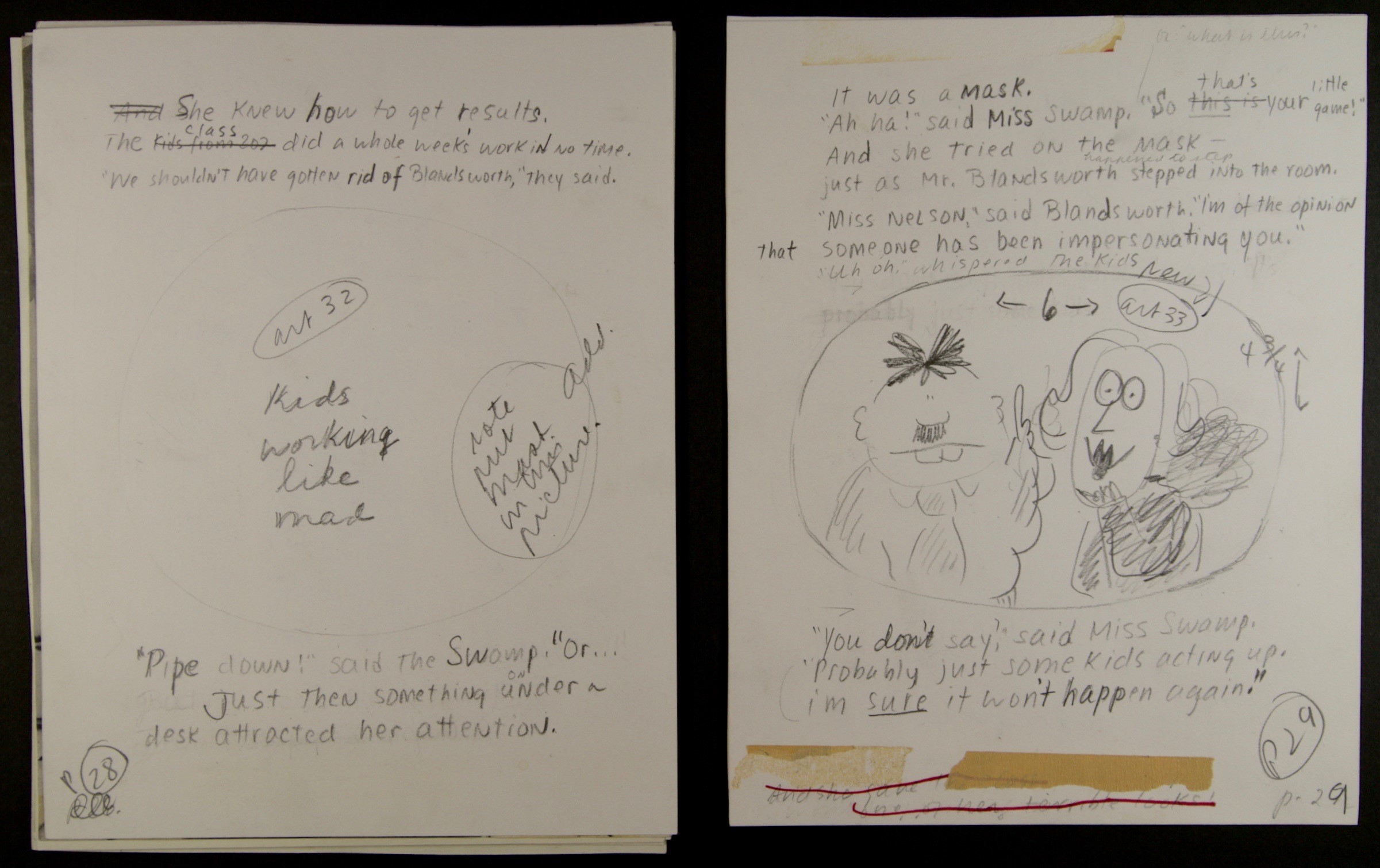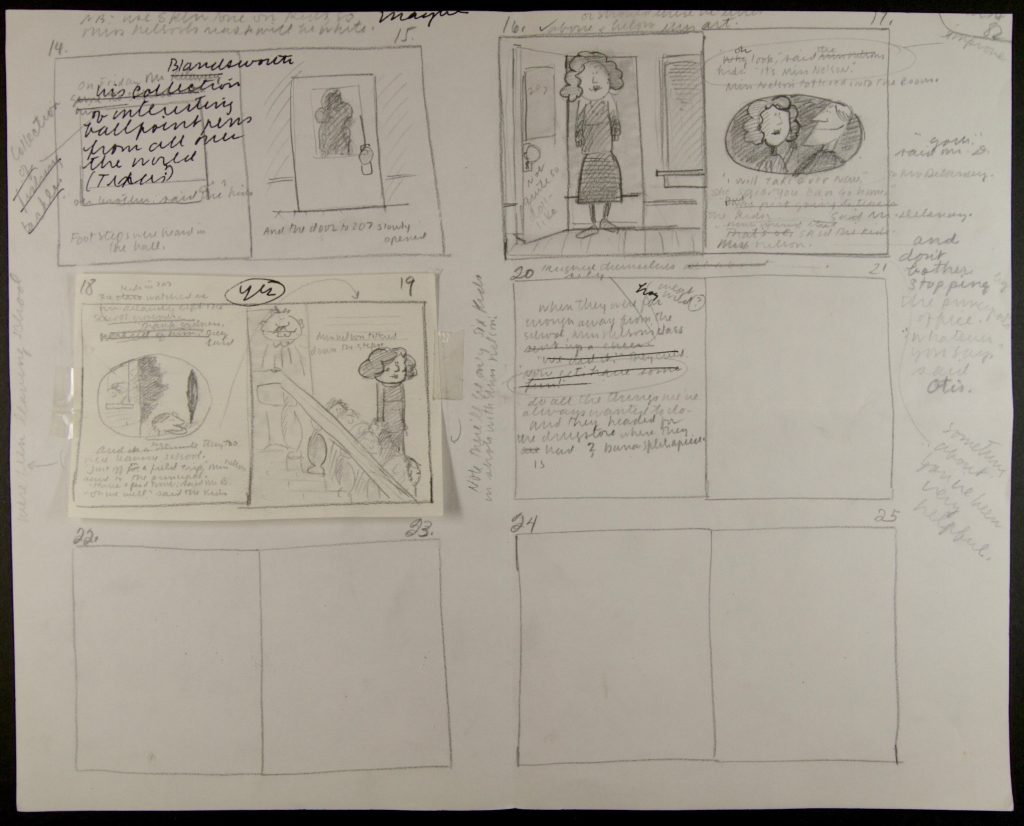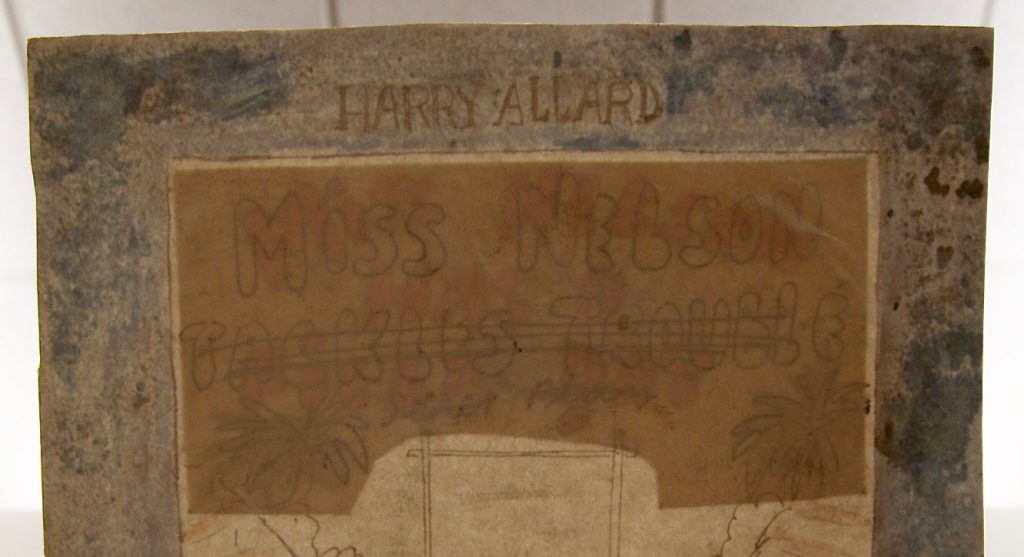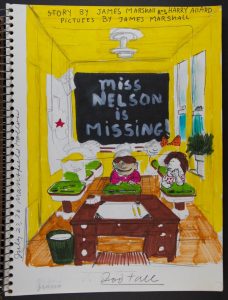The UConn Archives & Special Collections podcast d’Archive will release it’s 50th episode on April 24th, 2023 with a live broadcast at 10am EST on 91.7fm WHUS. Beginning in August of 2017, the Archives staff began expanding its outreach program to the airwaves by training on sound engineering and radio protocols in order to effectively bring its collections to new audiences. Since then the radio program and podcast has featured weekly episodes drawing from countless collections held by the Archives & Special Collections and amplifying the expertise of over 60 collaborators ranging from past and present archives and library staff, artists, journalists, curators, faculty, graduate and undergraduate students, high school students, visiting fellows and international students, activists, alumni, collectors and donors, family, and friends.
Continue readingCategory Archives: From the Researcher’s Perspective…
Pea Soup and Pink Loafers
The following guest post is by Elizabeth Barnett, recipient of the 2019 Billie M. Levy Travel and Research Grant. Ms. Barnett is an assistant professor of English at Rockhurst University in Kansas City, where she is the director of the Midwest Poets Series and editor of the Rockhurst Review. Her essays and poems have appeared in Modernism/modernity, Gulf Coast, and The Massachusetts Review. She is working, with great pleasure, on Marshall’s literary biography, tentatively titled Egads!
“But how then can you really care if anybody gets it, or gets what it means, or if it improves them. Improves them for what? For death? Why hurry them along? Too many poets act like a middle-aged mother trying to get her kids to eat too much cooked meat, and potatoes with drippings (tears). I don’t give a damn whether they eat or not.”
—Frank O’Hara, “Personism”
James Marshall’s voice had two kinds of drawls, the homey “ahs” of his Texas childhood—“I was told y’all are shy. You can’t be any shyer than I am”—and the playful “ohs” of the queer, East Coast communities he moved to soon after—“I live in New York as well as Connecticut and I go to galleries all the time and everything I see in painting is soooooo dull, suuuuuuch crap.” Marshall’s voice maps his identity. It also conceals it. A voice, as opposed to the words it speaks, can’t be “on the record,” so can supplement, complicate, and contradict those words.
I knew Marshall’s authorial voice—witty, warm, and weird—from gentle hippo friends George and Martha; sweet teacher Miss Nelson and her witchy alter ego, Viola Swamp; and the tragiocomedic Stupid family.[1]

More than 25 years after his death, I came to know Marshall’s actual voice when University of Connecticut archivist Kristin Eshelman guided me to an amazing and extensive cache of recordings. From 1976 to 1990 Marshall visited his friend, one-time landlady, and devoted admirer, Francelia Butler’s “kiddie lit” class most semesters, reading his stories; chatting about the art world, publishing industry, and their intersection in picture books; and, most revealingly, participating in Q&As. Thanks to the generosity of Billie Levy and the University of Connecticut Libraries, I was able to listen to the run of these tapes, which begin at the peak of Marshall’s career and end two years before his death of complications from AIDS.
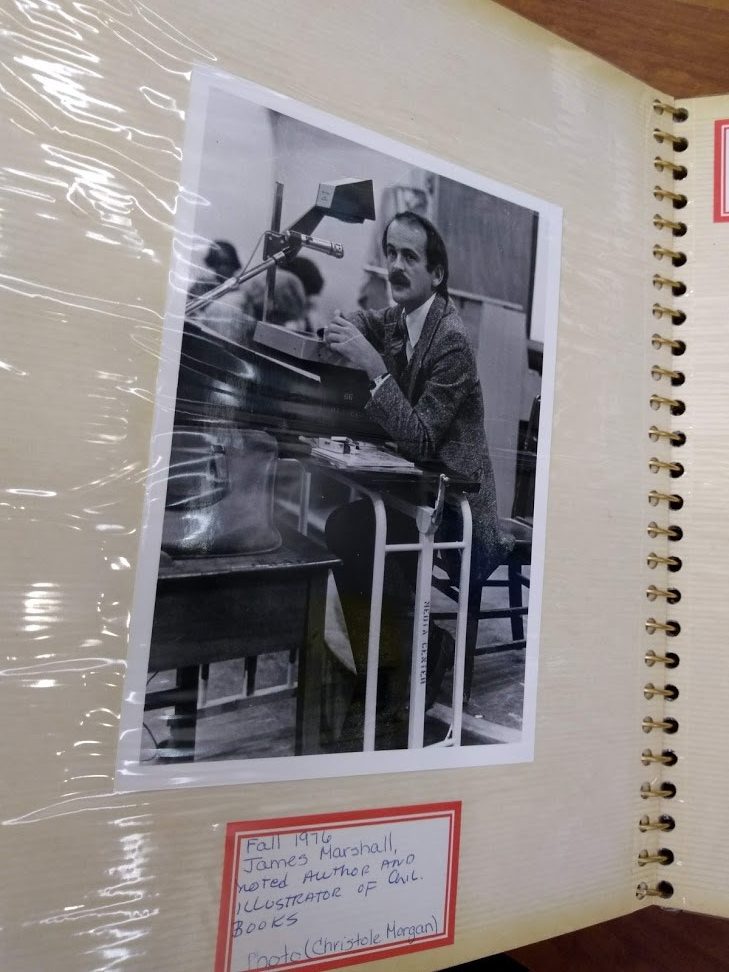
Marshall’s first visit, from the Fall 1976 class photo album. (The class made a photo album!). Francelia Butler Papers, Archives & Special Collections, University of Connecticut Library
A question I had for the tapes: how did Marshall navigate being a gay artist at a time when it was, full stop, impossible to be an openly gay man making books for children? Eavesdropping on those Regan-era, AIDS-blighted years, I never heard Marshall say he was gay. He never spoke as though he weren’t. Marshall’s authorial persona, distilled in his voice, suggests a key insight about his books, which also had to straddle the line between authentic artistic creations and market-dictated norms. What he says and how he says it are analogous to the words and pictures in one of his books. The voice says what the words can’t, just as the pictures, at times, undercut the moralistic conventions of children’s literature.
In Butler’s classroom, for example, I heard Marshall gesture to the limits of what he was allowed to say in an October 10, 1979, interaction with a female student. The student asked if Marshall was married. Marshall answered first with several beats of silence, then with a single word, “no,” then another beat of silence, then “I’m not” followed by a dismissive “next question.” The question asker perhaps wanted to catch Marshall out or perhaps didn’t understand what Marshall’s voice had been telling her. She asks an “innocent,” superficially unobjectionable question. But that banal surface hides (or not) the power of the dominant culture that the question summons. It really asks: Are you one of us? The asker uses the language of power and Marshall subverts that language by making it superfluous, his answer conveyed through silence and tone, not the words themselves.
This brief interaction reminded me of “Split Pea Soup,” the first story in 1972’s George and Martha, Marshall’s first book as both author and illustrator. It begins, “Martha was very fond of making split pea soup. Sometimes she made it all day long. Pots and pots of split pea soup.” These three simple sentences amplify each other and give a sense of something a little off about Martha’s soup making, the repetition mirroring Martha’s repetitive actions, recasting conventional domesticity as a less-cozy compulsion. Why is she making soup all day long? Why is she making so much? What begins in a normal place ends in a slightly absurd one. Or perhaps it’s just that the absurdity of normality comes through in the repetition. In the illustration, the framed slogan “Soup’s On” underlines Martha’s extreme enthusiasm for soup.
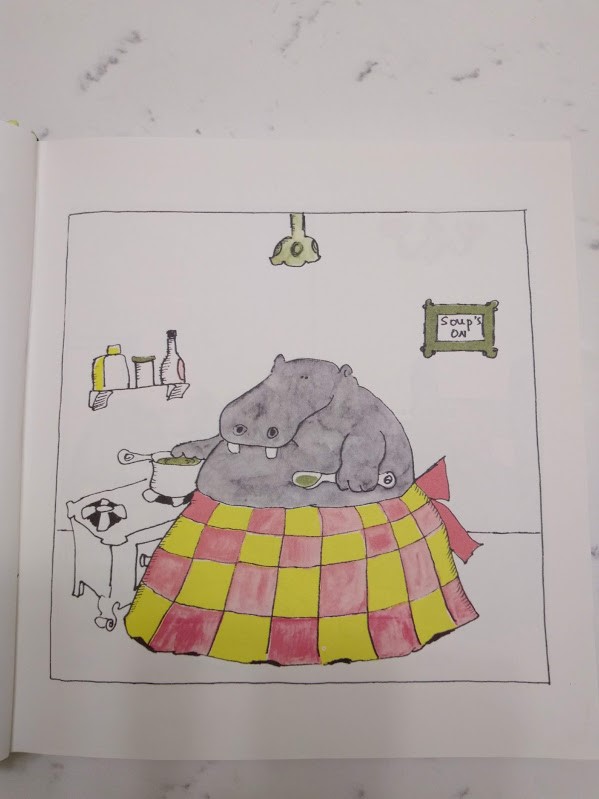
James Marshall, George and Martha
The illustration shows Martha, a hippo, in a massive checkered apron tied with an equally massive bow. She wears no other clothes. Her performance of femininity draws attention not to her femininity but its status as performance. (Here I echo and Marshall anticipates Judith Butler’s theorization of performativity). She is a topless large animal playing the part of a demure housewife. A drawn border surrounds the image, emphasizing that, like Martha in the kitchen, the book itself is performing. The redundant border puts “children’s story” in quotation marks by not allowing the page itself to function as the boundary, by insisting on something more artful, and by drawing attention to that artificiality.
So Martha loves making soup. We then learn that George hates split pea soup but eats it anyway to make Martha happy. However, he’s only hippo and reaches a point where he can eat no more. How, though, can he tell Martha that this good, normal thing she’s doing makes him miserable? He can’t—he pours the soup into his loafers. His pink loafers. And Martha catches him.
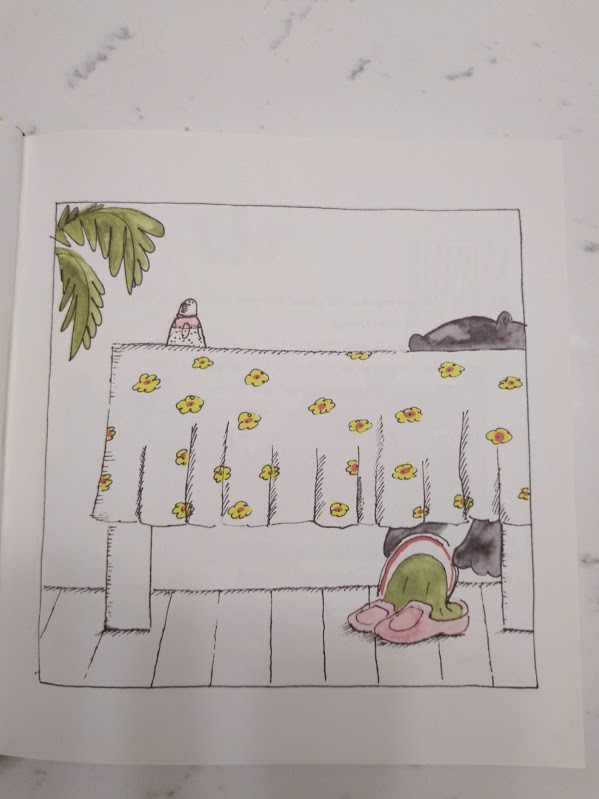
James Marshall, George and Martha
“Light in his loafers” was a common euphemism for homosexuality in the mid-century heyday of loafers and sexual repression. Pink is coded as female or gay. Until a new, more economical method of full-color printing was pioneered in Japan in the mid-1980s, most of Marshall’s illustrations were color overlays, which means that Marshall drew the picture then traced each thing that he wanted to be yellow, or blue, or red onto separate sheets of paper and colored those in with graphite, indicating if any colors were to be diluted by giving the percentage of that color to be applied. All to say, the pink was absolutely a deliberate choice.
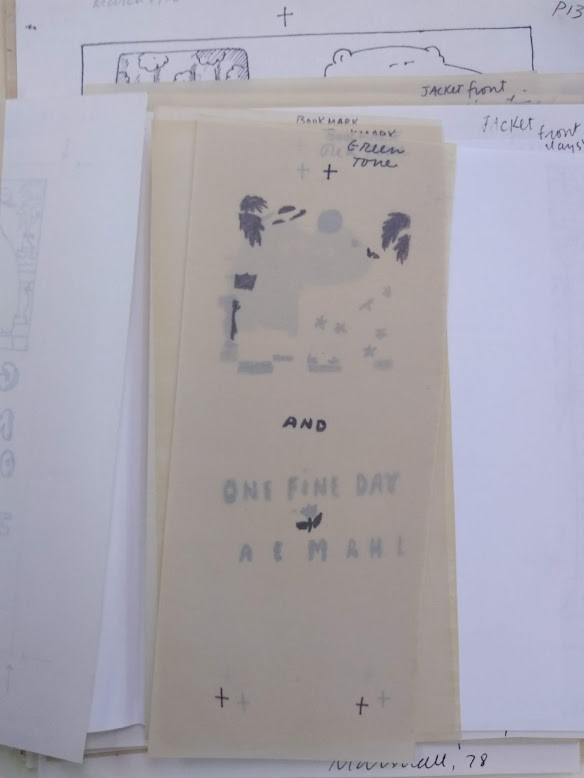
Example of color overlay from George and Martha One Fine Day. de Grummond Children’s Literature Collection, University of Southern Mississippi.
George’s disposal of the soup in his loafers might be read as a symbolic refusal of compulsory heterosexuality. It is also a refusal of language, suggesting the complicity between the two. George “says” he hates the soup through his actions because language would imbricate him in the very power structure he’s resisting. I see Martha as the question-asker here. She is playing the feminine role as she’s supposed to. She’s aligned with the dominant culture. George is Marshall; he can’t tell Martha he hates the soup because here she is doing exactly what she’s supposed to do (however inane), and he’s messing it up. George avoids the language trap just as author/illustrator Marshall does—they don’t put the subversive part into words.
The too-pat ending of “Split Pea Soup,”—Martha tells George, “Friends should always tell each other the truth,” and they eat chocolate chip cookies—to me signals that Marshall wants his reader to feel the tension between what the story says and what it means. I probably think that because that’s what I hear happening in the classroom interactions on the archive’s audio tapes. Marshall’s language, punctuated with strategic silences and curtness, insists on its own inadequacy, drawing an arrow to what’s left out. The story’s sharp turn to the didactic reads to me like the drawn border around the illustrations. It signals its own performativity, here of the norms of the picture book, which are weakened, rather than reinforced, by their inclusion.
Frank O’Hara’s 1959 critique of poetry-as-moral-vitamin anticipates Marshall’s later refusal of children’s literature’s didactic imperative. In both cases, queer writers already existed outside of mainstream culture, their morality maligned by that culture. It follows they may have been especially wary of the inherent value of literature being used for ethical indoctrination. Both suggest the value of their art form is not the moments it teaches us something, but the moments it refuses to.
In 1979 Marshall “answered” the student
question with words that would not endanger his art and livelihood. Marshall’s delivery suggests he wants the
audience to know that’s why he’s saying them. The performative conformity is
one way to understand the more conventional moments in Marshall’s startlingly
original body of work. He tells us when he’s playing by the rules to protect
the magic of when he’s not.
[1] The latter credit Harry Allard with authorship but, as Jerrold Connors convincingly argues in his post on this site, and Marshall’s materials confirm, Allard often provided the creative spark for a piece, but Marshall shaped the narrative and the finished prose.
“Thinking with my hands” in the Archive: Second Generation New York School Gems
Currently a postdoctoral fellow in the School of Literature, Media and Communication at Georgia Institute of Technology, Dr. Nick Sturm is an Atlanta-based poet and scholar. His poems, collaborations, and essays have appeared in The Brooklyn Rail, PEN, Black Warrior Review, The Best American Nonrequired Reading, and elsewhere. His scholarly and archival work on the New York School of poets can be traced at his blog Crystal Set. He was awarded a Strochlitz Travel Grant in 2018 to conduct research in the literary collections, including the Notley, Berrigan, and Berkson Papers, that reside in Archives and Special Collections.
In my first-year writing course at the Georgia Institute of Technology in Atlanta where I teach as a Marion L. Brittain Postdoctoral Fellow, my students are reading books by Second Generation New York School poets to critique and creatively reimagine concepts of youth, coming-of-age narratives, and the overlap between do-it-yourself and avant-garde aesthetics. We already read Joe Brainard’s I Remember and Ted Berrigan’s The Sonnets, two versions of youth, memory, and selfhood constructed by male poets of the New York School, and were beginning to read Alice Notley’s Mysteries of Small Houses (1998) to extend this intertextual conversation about youth through the perspective of a female poet. While re-reading Mysteries, a book of autobiographical poems that tracks Notley’s “I” through the prismatic complexities of life and writing, I returned to her poem “Waveland (Back in Chicago)” in which Notley, challenged by the responsibilities and strictures of living inside concepts like motherhood and femininity in the mid-’70s, describes her process of collage-making, a practice Notley continues to be devoted to.
Frozen collection of world—this is “art” I don’t
write much poetry;
I’m thinking with my hands—a ploy against fear—
I have a pile of garbage on the floor
The poem then catalogs a series of collages with titles like “WATERMASTER” and “DEFIES YOU THE RHYTHMIC FRAME,” and also describes a collage composed of “a photo of a stripper I’ve named / Barney surrounded by cutout words she / dances to poetry.” Reading these lines, I remembered that I had actually just seen this collage in Notley’s papers at the University of Connecticut. Among a couple dozen collages by Notley, there was Barney herself, headless, cape trailing behind her, walking across a fragment of moon. After discussing this poem in class, I was able to show my students 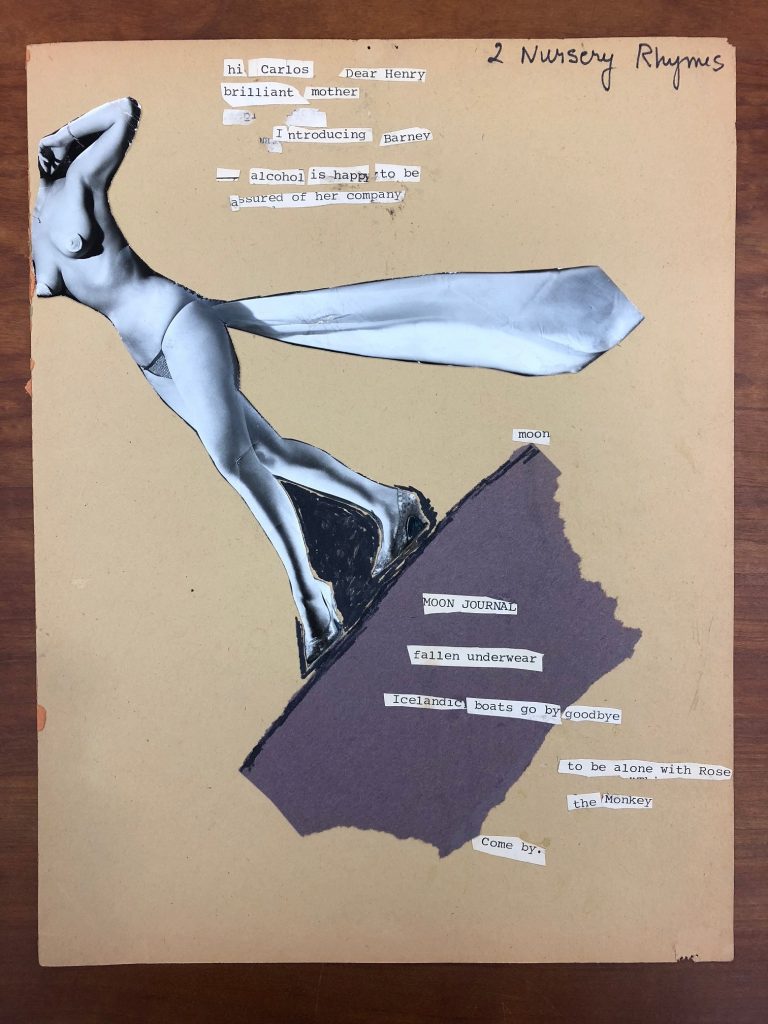 the collage to talk about how seeing an example of Notley’s visual art helped us think about her critiques of femininity, motherhood, and aesthetics. Students were surprised that I had such an example to show them—what had seemed like a passing reference in a poem suddenly become material. They immediately started to describe the effects of juxtaposing the collage’s title “2 Nursery Rhymes” with the presence of a nearly-nude woman. They asked what it might mean for Notley to be a “brilliant mother” in association with the mythological feminine connotations of the moon. And they noted how the epistolary gesture that opens the collage’s text, “hi Carlos Dear Henry,” resonated with Berrigan’s The Sonnets, which is riddled with salutations like “Dear Marge,” “Dear Chris,” and “Dear Ron.” Seeing Notley’s collage projected in front of them, pairing the material evidence of the poem’s description with a conversation about how the visual medium supplemented their reading of the text, students said they felt a different connection to the poem, to Notley’s work, and to our entire discussion that day.
the collage to talk about how seeing an example of Notley’s visual art helped us think about her critiques of femininity, motherhood, and aesthetics. Students were surprised that I had such an example to show them—what had seemed like a passing reference in a poem suddenly become material. They immediately started to describe the effects of juxtaposing the collage’s title “2 Nursery Rhymes” with the presence of a nearly-nude woman. They asked what it might mean for Notley to be a “brilliant mother” in association with the mythological feminine connotations of the moon. And they noted how the epistolary gesture that opens the collage’s text, “hi Carlos Dear Henry,” resonated with Berrigan’s The Sonnets, which is riddled with salutations like “Dear Marge,” “Dear Chris,” and “Dear Ron.” Seeing Notley’s collage projected in front of them, pairing the material evidence of the poem’s description with a conversation about how the visual medium supplemented their reading of the text, students said they felt a different connection to the poem, to Notley’s work, and to our entire discussion that day.
Of course, none of this would have been possible without my recent visit to the archives at the University of Connecticut. Thanks to the generosity of a Rose and Sigmund Strochlitz Travel Grant, I spent a week in the papers of poets and artists like Notley, Ted Berrigan, Bill Berkson, and Ed Sanders, among others, reading voluminous correspondence with Joe Brainard, Anne Waldman, Bernadette Mayer, Lewis Warsh, Ron Padgett, and a litany of other Second Generation New York School writers. Well-known for its Charles Olson Research Collection, the Thomas J. Dodd Research Center is also home to a wealth of materials associated with the New York School and is a necessary destination for any scholar of 20th century American poetry. And though a week of nonstop work in the archive allowed me to read and assess a lot of material, the sheer amount of New York School material stored at UConn, much of which has only barely begun to be utilized by scholars, meant that I was inevitably rushing through stacks of papers, quickly unfolding and refolding letters, swiftly scanning folder titles, and scratching my own nearly incomprehensible notes in a frenzied, focused attempt to see and catalog as much as possible before having to return to Atlanta. Like Notley’s description of collage-making in Mysteries, the archive is a place where I’m also “thinking with my hands” as I arrange, photograph, and order material in “a ploy against [the] fear” of overlooking or not knowing the full extent of what’s present in the archive. Every piece of material, like in Notley’s collage, is necessary and meaningful. This is how “a pile of garbage” becomes both art and scholarship. Starting with what you touch, a life and intelligence are animated.
Notley wasn’t the only poet whose visual artwork is held at the University of Connecticut. Take this incredible poster-size collage “Blues Bombard” (1965) by Ron Padgett with the poet’s thick, elegant cursive painted over sliced fragments of sheet music that frame a photo booth portrait of Padgett, face half-obscured, cool, and mysterious. It’s rare to find visual artwork by Padgett that isn’t a collaboration with friends like Brainard or George Schneeman, and this piece is particularly astounding both for its size and the quick, pleasing, and humorous visual narrative that follows from the newspaper clipping-title, down across the rhyming and chiding main text ”more than likely this stinks greatly,” the arrows and question marks that logically and quizzically suggest a set of correspondences, the appearance of the artist mid-gesture, and the small, humorous, non sequitur conclusion “a hole in one. THE END.” It’s a lovely piece, and entirely Padgett in its cartoonish wit and simplicity.
 I was also interested to work in Ed Sanders’s papers at UConn, which includes a wealth of material from the Peace Eye Bookstore, the infamous “secret location on the lower east side” where Sanders’s mimeograph magazine Fuck You: A Magazine of the Arts was published from 1962-65 until the store was raided by the NYPD on obscenity charges. Incredibly enough, the collection includes both a handwritten note from 1964 instructing Sanders to call an FBI agent and Sanders’s January 1965 mugshot following his arrest. After Sanders defeated the charges against him, Peace Eye temporarily reopened in 1967 with a Fuck You-style gala event auctioning off “literary relics & ejeculata from the culture of the Lower East Side.” The collection includes the handwritten notecards Sanders used to identify the various items for sale in the auction, like an “iron used by rising young poets to iron the buns of W.H. Auden during the years 1952-1966,” “Allen Ginsberg’s Cold Cream Jars,” and a letter—likely in protest—from Marianne Moore to Sanders in response to receiving a copy of Fuck You in the mail. Some of the material actually confiscated by the NYPD in the raid of the bookstore is in the collection as well, with the police evidence identification slips still attached, like a copy of a Joe Brainard drawing described by police as “Blue colored Headless Superman drawing with private parts exposed.”
I was also interested to work in Ed Sanders’s papers at UConn, which includes a wealth of material from the Peace Eye Bookstore, the infamous “secret location on the lower east side” where Sanders’s mimeograph magazine Fuck You: A Magazine of the Arts was published from 1962-65 until the store was raided by the NYPD on obscenity charges. Incredibly enough, the collection includes both a handwritten note from 1964 instructing Sanders to call an FBI agent and Sanders’s January 1965 mugshot following his arrest. After Sanders defeated the charges against him, Peace Eye temporarily reopened in 1967 with a Fuck You-style gala event auctioning off “literary relics & ejeculata from the culture of the Lower East Side.” The collection includes the handwritten notecards Sanders used to identify the various items for sale in the auction, like an “iron used by rising young poets to iron the buns of W.H. Auden during the years 1952-1966,” “Allen Ginsberg’s Cold Cream Jars,” and a letter—likely in protest—from Marianne Moore to Sanders in response to receiving a copy of Fuck You in the mail. Some of the material actually confiscated by the NYPD in the raid of the bookstore is in the collection as well, with the police evidence identification slips still attached, like a copy of a Joe Brainard drawing described by police as “Blue colored Headless Superman drawing with private parts exposed.”
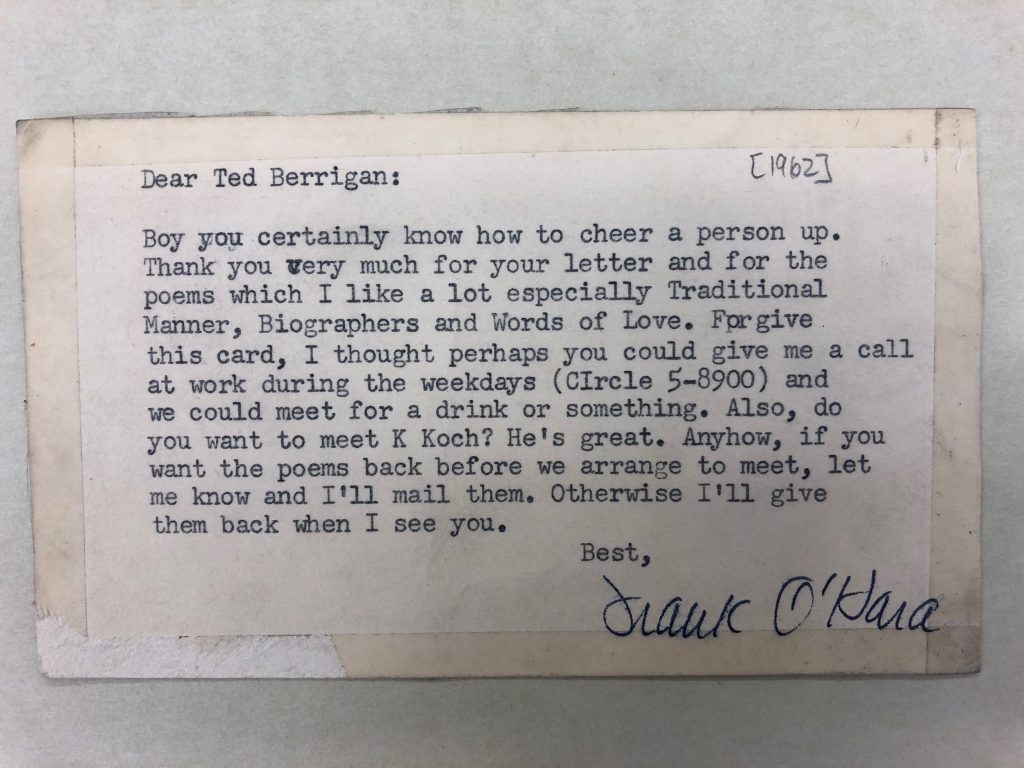 Among collages and obscenity charges, the New York School material at UConn also runs parallel to and benefits from the archive’s already well-known collections of Frank O’Hara and Charles Olson papers. The resonance of these collections is embodied in two postcards; one from Frank O’Hara to Ted Berrigan and another from Berrigan to Charles Olson. Much can be made of the micro-lineage threads of the New American poetry and New York School that run through these three poets. Not only are Olson and O’Hara canonical energies within Berrigan’s The Sonnets, but Berrigan’s self-described “rookie of the year” arrival in American poetry occurred at the 1965 Berkeley Poetry Conference, over which Olson’s presence loomed large. Additionally, O’Hara’s work had been a guide for Berrigan on how to live as a young poet. What’s great about the 1962 postcard from O’Hara to Berrigan is that it offers a reversal on the standard hierarchical narratives of literary tradition. Here, it’s O’Hara praising Berrigan’s poems as he invites him out for a drink and “to meet K. [Kenneth] Koch,” who would also be a New York School hero to Berrigan. Evidenced by the tape arranged on the edges of the card to harden and preserve it, Berrigan clearly treasured this correspondence from O’Hara, which due to the use of Berrigan’s full name, seems to have been their very first formal exchange. One images Berrigan, then 27 years old and having just moved to New York City the year before, formally expressing his admiration for O’Hara’s poems in his initial note. This postcard shows Berrigan’s first-hand devotion to his aesthetic sources. On the other hand, the August 16, 1966 postcard from Berrigan to Olson reveals an already well-established and easy going correspondence with the author of The Maximus Poems and “Projective Verse,” as Berrigan, referencing the postcard’s text on the other side, writes, “Dear Charles, We’re about to beat upwind. A loon is crying tonight. Maine is full of sky,” and signs off, “Be seeing you, Ted + Sandy.” Likely having stopped in to see Olson in Gloucester, Massachusetts on the drive up to Maine with his first wife, Sandy, Berrigan is playfully following up with the elder poet only about three weeks after the death of O’Hara.
Among collages and obscenity charges, the New York School material at UConn also runs parallel to and benefits from the archive’s already well-known collections of Frank O’Hara and Charles Olson papers. The resonance of these collections is embodied in two postcards; one from Frank O’Hara to Ted Berrigan and another from Berrigan to Charles Olson. Much can be made of the micro-lineage threads of the New American poetry and New York School that run through these three poets. Not only are Olson and O’Hara canonical energies within Berrigan’s The Sonnets, but Berrigan’s self-described “rookie of the year” arrival in American poetry occurred at the 1965 Berkeley Poetry Conference, over which Olson’s presence loomed large. Additionally, O’Hara’s work had been a guide for Berrigan on how to live as a young poet. What’s great about the 1962 postcard from O’Hara to Berrigan is that it offers a reversal on the standard hierarchical narratives of literary tradition. Here, it’s O’Hara praising Berrigan’s poems as he invites him out for a drink and “to meet K. [Kenneth] Koch,” who would also be a New York School hero to Berrigan. Evidenced by the tape arranged on the edges of the card to harden and preserve it, Berrigan clearly treasured this correspondence from O’Hara, which due to the use of Berrigan’s full name, seems to have been their very first formal exchange. One images Berrigan, then 27 years old and having just moved to New York City the year before, formally expressing his admiration for O’Hara’s poems in his initial note. This postcard shows Berrigan’s first-hand devotion to his aesthetic sources. On the other hand, the August 16, 1966 postcard from Berrigan to Olson reveals an already well-established and easy going correspondence with the author of The Maximus Poems and “Projective Verse,” as Berrigan, referencing the postcard’s text on the other side, writes, “Dear Charles, We’re about to beat upwind. A loon is crying tonight. Maine is full of sky,” and signs off, “Be seeing you, Ted + Sandy.” Likely having stopped in to see Olson in Gloucester, Massachusetts on the drive up to Maine with his first wife, Sandy, Berrigan is playfully following up with the elder poet only about three weeks after the death of O’Hara.  Though Olson himself would die in 1970, and it’s unclear if further correspondence between the two poets exists, Berrigan’s “full of sky” note to Olson again shows his sense of intimacy with the poets whose work he respected and learned from. The archive, as it often does, is showing us how lineage, tradition, and aesthetic exchange are never abstract.
Though Olson himself would die in 1970, and it’s unclear if further correspondence between the two poets exists, Berrigan’s “full of sky” note to Olson again shows his sense of intimacy with the poets whose work he respected and learned from. The archive, as it often does, is showing us how lineage, tradition, and aesthetic exchange are never abstract.
I’m looking forward to returning to the archives at the University of Connecticut to spend more time thinking through the material traces of the poets I love and study, and to continue to utilize these important and still-growing collections to illustrate the ongoing importance and value both of the New York School’s second generation gems and the pedagogical, personal, and scholarly correspondence that archives allow us to develop. “I must be making my own universe / out of discards,” Notley writes in “Waveland (Back in Chicago),” and there’s a sense of that same construction of a world in the loose, wayward ephemera of the archive. What’s most fulfilling is how the process of looking and reading in the archive is always one of presence, and often magically, of being in contact with your sources.
-Nick Sturm
The Search and Struggle for Intersectionality Part II: Other Minorites and the Feminist Movement
Anna Zarra Aldrich is majoring in English, political science and journalism at the University of Connecticut. As a student writing intern, Anna is studying historical feminist publications from the collections of Archives and Special Collections. The following guest post is the final post in the series.
The feminist movement has long struggled with incorporating different groups’ concerns and modes of oppression into the movement. This problem was exacerbated by the multifaceted, turbulent U.S. political atmosphere that characterized the 1960s and 1970s. The differences between black and white women’s views of the movement clashed on several essential dimensions. But the issues of other minority groups were given less attention by the feminist movement, and by society in general, due to the fact that their ethnic/racial factions were much smaller than African Americans’.
Another marginalized group that galvanized in the activist culture of the 1960s and 1970s in America were Native Americans. These men and women sought to have their tribal autonomy recognized. They were also fighting issues such as environmentally harmful mining practices on their resource-rich lands and high rates of substance abuse and poverty within their communities.
Native American women had a unique relationship with the feminist movement because the issues this minority group faced were different from those that white or black women faced, and the ethnic population of which they were a part was a severely marginalized minority. U.S. Census data from 1970 shows that a whopping 98.6 percent of the total population was either white or black/African American (87.5 percent and 11.1 percent respectively). Native Americans constituted less than .004 percent.

Native Americans were fighting for their unique political rights as well as larger environmental concerns during this period.
The March 1977 issue of “Off Our Backs” includes an article summarizing the findings of a report by the Association on American Indian Affairs (AAIA), a non-profit organization founded in 1922 to promote the well-being of Native Americans and Alaskan Natives. The report found that Native American children are placed outside of their families at a rate 10 to 20 times higher than that for non-Native American children.
The AAIA argued that this practice deprives Native American children of the ability to be raised with a proper awareness of and appreciation for their culture. This concern emphasizes the fact that Native American women who were involved in the feminist movement during this time were simultaneously combatting the United States government’s systematic efforts to diminish their independence and culture as well as the wide-spread sexism that was the feminist movement’s main concern.
Native American culture celebrates its strong connection to and appreciation of nature. When Native American tribes were forced off their lands in the nineteenth century, they were put on reservations in states like Oklahoma and South Dakota. The U.S. government later came to realize these areas were rich with natural resources such as oil and uranium.
“In the days of diminishing U.S. energy resources, the push is on to take what’s left of Indian land,” according to an article in “Off Our Backs.”
The U.S. government used environmentally hazardous practices to extract these resources, exposing people living on the land to cancer-causing radioactive materials. It also paid the Native Americans working in these hazardous mines very low wages. These practices led to outcry by Native American men and women.
In 1978, thousands of Native Americans participated in The Longest Walk, a protest organized to bring attention to threats to tribal lands pose by several pieces of proposed legislation.
“In effect, these bills could force Native Americans to complete assimilation into the U.S. mainstream and destroy all sovereignty of the Indian nations,” the article on the march said.
In the same August/September 1978 issue that covered the march, “Off Our Backs” included coverage of a conference in New Mexico that addressed the upsurge in domestic violence against Navajo women. This increase was attributed to a “pressure cooker syndrome” created by white culture: “women-battering and child abuse (were) once practically non-existent…and has now reached crises proportions.”
The attempted forced assimilation of native people into white culture created a class system that did not exist in Navajo tribal society. This led to high poverty and unemployment rates which in turn came to be correlated with high rates of substance abuse and domestic violence.
The writers draw attention to the fact that few of the speakers at the conference were from the Navajo or from any other Native American community. Calling attention to the lack of authentic representation at this conference may be an indication of the evolution of “Off Our Backs” in how it dealt with minority issues. When the paper first began in 1970, it struggled to expand their coverage to minority women’s issues, as evidenced by its problematic coverage of a black feminist group’s conference in 1974.
Similar to black women who were involved with groups like the Black Panthers, politically active Native American women were part of efforts led by men. Women of All Red Nations (WARN) was a Native American women’s group that brought attention to issues that affected their community including the displacement of their children, forced sterilization, tribal rights, resource exploitation and racism in the educational system. The group invited several Native American men to speak at a conference it held in South Dakota in 1978 as it did not “believe in the separation of men and women who were working for the same objective.” This serves as a perfect parallel to black women activists who wanted to be a part of the black and feminist movements.
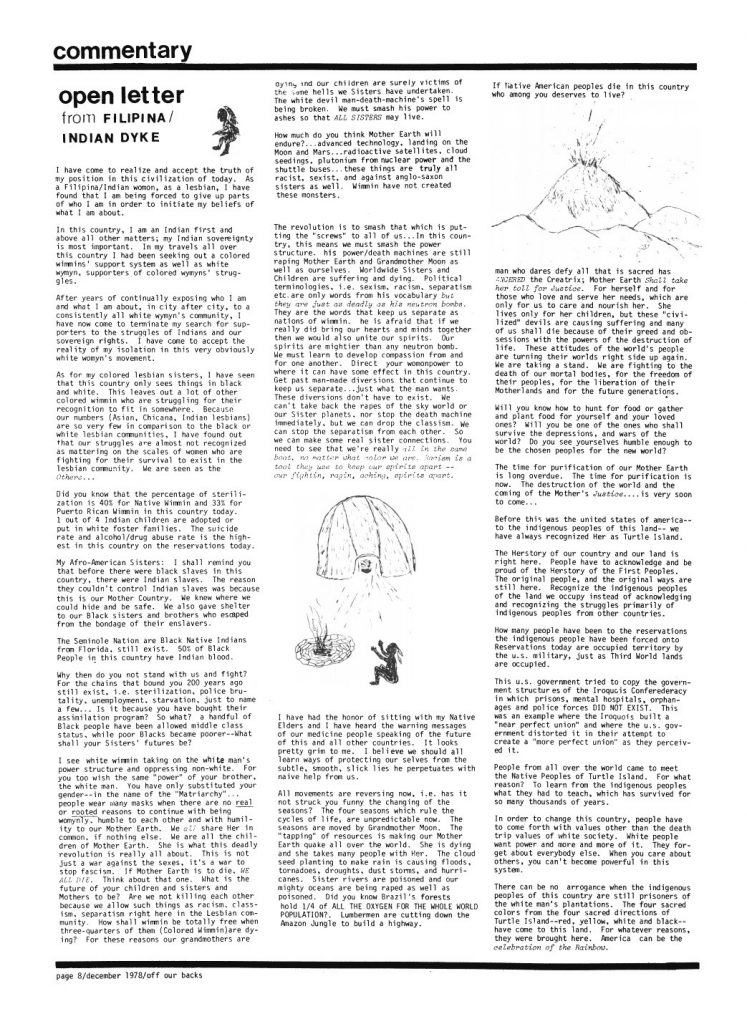
Burning Cloud’s letter serves as a quintessential example of a woman’s struggle to find a way to be politically active as someone with a complex set of oppressed identities.
In the December 1978 issue of “Off Our Backs,” the editors printed a letter from Burning Cloud, a self-described “Filipina/Indian Dyke.” In the letter, Burning Cloud shared a sentiment common with those expressed by black women — that she was “Indian first and above all other matters.”
Burning Cloud felt she could not be both an Indian and a gay woman in society. She also expressed frustration with the fact that non-black minorities’ concerns are much more widely disregarded because there are comparatively few of them in number.
Burning Cloud’s letter included a call to action for environmental activism which, from her perspective, was something of which native people were much more conscious due to their spiritual cultural connections to the earth.
“If Mother Earth is to die WE ALL DIE. Think about that one. What is the future of your children and sisters and mothers to be?” she wrote. “Are we not killing each other because we allow such things as racism, classism, separatism right here in the Lesbian community. How shall wimmin be totally free when three-quarters of the (Coloured Wimmin) are dying?”
(Feminists took to using alternative spellings of “women” and “woman” in order to avoid using the masculine root of those words.)
Native American women also faced the issue of forced or coerced sterilization. In “Off Our Backs” article from December 1978, WARN said that 25 percent of Native American Women were forcibly sterilized.
During this period, the United States government instituted polices of population control that targeted minority, underclass women. One third of Puerto Rican woman of reproductive age had been sterilized in 1976. This policy was veiled as a necessary method of population control that would help Puerto Rico develop economically. However, many argued that the problem was not overpopulation, rather that the available resources were concentrated in the upper echelons of society.
In her 1976 University of Connecticut Ph.D. thesis “Population Policy, Social Structure and the Health System in Puerto Rico: The Case of Female Sterilization,” Peta Henderson found that in addition to medical reasons, the law in Puerto Rico regarding female sterilization allowed for women to be sterilized or use other contraceptive methods in cases of poverty or already having multiple children. Henderson found that most sterile Puerto Rican women said they voluntarily chose to have the operation. However, she explores how this choice was corrupted by the fact that government actors worked to persuade these women that sterilization was in their best interest.
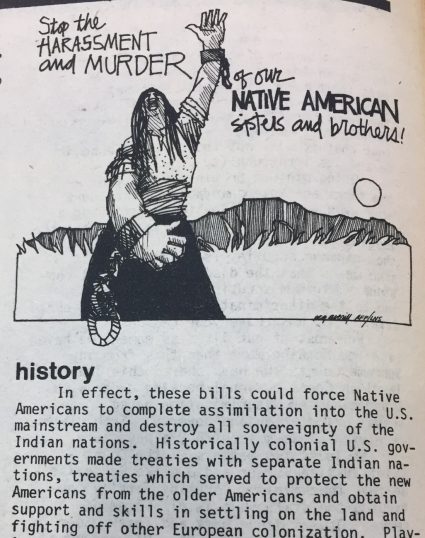
The U.S. Government put forth the idea that having fewer children was the surest path to wealth for minority women, ignoring institutional issues including racism and sexism that impeded their social mobility.
These kind of population control polices were also implemented elsewhere in Latin America.
The April 1970 issue of “Off Our Backs,” a female member of the Peace Corps who went to Ecuador said, “Providing safe contraceptives must be a part of a comprehensive health program,” Rachel Cawan said. “Most importantly, however, there must be available other emotionally satisfying alternatives to child raising.”
The prevailing feminist interpretation of these population control programs was that they masqueraded as liberating family planning alternatives when, in fact, many of these women were being coerced or forced to stop having children.
The Young Lords Party was founded in 1960. The men who founded the organization had a series of objectives including self-determination for Puerto Rico, liberation for third-world people and, problematically, “Machismo must be revolutionary and not oppressive.”
Early in the party’s history, the men in the movement did not listen to women’s ideas and concerns during meetings. These women were limited to essentially being glorified secretaries for the party according to a November 11, 1970 New York Times article.
The women in the movement soon tired of this dynamic and demanded to be taken seriously – and they succeeded. Several women were able to assume leadership positions in the party and the pillar relating to machismo was changed to one supporting equality for women. However, this victory did not mean women were automatically able to achieve true political and social equality within the party or on a larger scale.
In a subsequent issue of “Off Our Backs,” a black/Native American woman wrote a response to Burning Cloud’s letter, which had also said black people should support Native Americans’ issues, saying that: “There is a need for Dialogue, a conversation, between Indian people and Black people…We have been divided in order to be conquered, even though for many, our blood flows together.”
A theme that emerges again and again when studying the second-wave of the feminist movement is that by separating women into sects with seemingly irreconcilable differences, men have managed to prevent them from forming a powerful united front capable of combatting not only sexism, but racism and other social ills that afflict them.
-Anna Zarra Aldrich
The Search and Struggle for Intersectionality Part I: Black Women and the Feminist Movement
Anna Zarra Aldrich is majoring in English, political science and journalism at the University of Connecticut. As a student writing intern, Anna is studying historical feminist publications from the collections of Archives and Special Collections. The following guest post is one in a series to be published throughout Spring 2018.
The feminist movement has long struggled with incorporating different groups’ concerns and modes of oppression into the movement. This problem was exacerbated by the multifaceted, turbulent U.S. political atmosphere that characterized the 1960s and 1970s.
“Chrysalis,” a quarterly women’s periodical that was self-published in Los Angeles from 1976-1980, struggled to incorporate African American women’s issues into its editors’ ideals for the movement. In an issue of the magazine that came out in spring of 1979, poet Adrienne Rich wrote an article called “Disloyal to Civilization: Feminism, Racism and Gynophobia.”

“Chrysalis’s” article sharing the story of Annie Mae was a clear attempt to give a black woman a voice in the publication.
Rich’s article emphasized some of the inherent similarities between the struggles of black people and women in America. She wrote that all women and all black people in this country live in fear of violence being committed against them solely due to their gender or race without the hope of justice being served.
Her article went on to explain that dividing women against each other has historically been a means by which men have maintained their oppression: “The polarization of black women in American life is clearly reflected in a historical method which, if it does not dismiss all of us altogether or subsume us vaguely under ‘mankind,’ has kept us in separate volumes or separate essays in the same volume.”
Rich urged women that they “can’t keep skimming the surface” of the women’s movement by refusing to engage with black women’s issues.
“Chrysalis’s” winter 1980 issue featured a story called “I am Annie Mae” which was the story of Annie Mae Hunt, a 70-year old black woman from Texas. Annie Mae’s story was told through a transcript of hours of interviews.
Annie Mae’s story shared the hardships of her life, including her dropping out of school after fifth grade, getting married and having her first child when she was only 15. Annie Mae was pregnant a total of 13 times in her life and had six living children at the time of the article’s publication. Annie Mae said she was never educated about birth control and was told having more children was better for her.
“Birth control – that wasn’t in the makings then. I mean the black people didn’t know it. Poor people like me. There may have been some well-to-do people that knew about it,” Hunt said.
While this article was an earnest effort by “Chrysalis” to tell the story and plights of a woman of color, it was only through a white mouthpiece that Annie Mae was able to share her story; the reporter who conducted and organized the interviews was white as was the staff and, presumably, much of the magazine’s readership. Furthermore, aside from Rich’s essay and this article, examples of “Chrysalis” covering women of color’s issues are sparse.
“Off Our Backs,” a bi-weekly newspaper printed in Washington D.C. (1970-2008) did put forth a more valiant effort to communicate the struggles of black women in America through their own voices even if they often fell short of true intersectional understanding.
In the April 15, 1971 issue of “Off Our Backs” an unnamed black woman, identified as someone who held a “high position in the Health, Education and Welfare Department,” was interviewed about her response to the women’s liberation. She pointed out at that at time the women’s movement was predominantly led by and composed of white, middle class women. She said that black women do not want to be a part of what they considered to be a, frankly, racist movement.
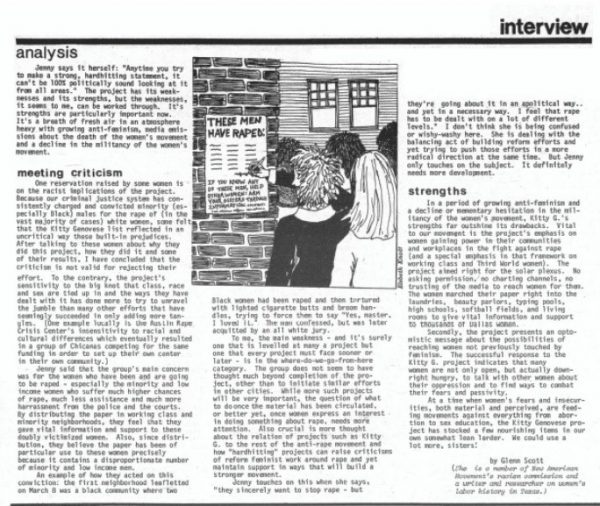
In their article on the Kitty Genovese Women’s Project, “Off Our Backs,” asks directly about this criticism of racial bias.
The 1960s and 70s were a period rife with tension in multiple dimensions, only one of which was the women’s lib movement. This period saw the continuing struggle by African Americans for equality and civil rights. The woman interviewed for the April 15 article emphasized that she, and many other black women, identified as black first and a woman second in terms of their identity and sources of oppression.
In 1977, the Kitty Genovese Women’s Project, named for the woman who was murdered while numerous people who were aware of what was happening did nothing, posted a list of 2,1000 male sex offenders in Dallas County. A group of 30 women handed out over 20,000 copies of the list. Many black feminists took issue with the list as black men were disproportionately represented due to a higher conviction rate among blacks for all crimes due to the racial bias of the criminal justice system.
In 1966, the militant civil rights activist group the Black Panthers formed in in Oakland California. Many black women were involved in the black movement and wanted to work with the men in that movement to achieve their collective goals. Many white feminists, however, argued for a complete break with men.
This argument originated during the first wave of feminism in the United States. Some male abolitionists argued that it was the “Negro’s Hour,” during the last ninetieth century, to quote Wendell Phillips. Men such as Phillips, and Frederick Douglass believed the main focus of the period had to be black men’s rights and that women’s suffrage would have to be pushed to the back burner.
This led women’s suffrage leaders like Elizabeth Cady Stanton and Susan B. Anthony to found the women’s-only National Woman Suffrage Association. This break from the abolition movement may be viewed as a break from black issues in general, which sowed the seeds for the division that reemerged in the next phase of the movement.
In June 1979, “Off Our Backs” published a special “Ain’t I a Woman” issue, named for a famous speech given by Sojourner Truth at the 1851 Women’s Rights Convention in Akron, Ohio. Truth’s speech confronted the stark differences between the treatment of white and black women: “Nobody ever helps me into carriages, or over mud-puddles, or gives me any best place! And ain’t I a woman?”
The special issue included a statement from the Combahee River Collective, a black feminist group from Roxbury, Massachusetts. The statement said: “As black women, we see black feminism as the logical political movement to combat the manifold and simultaneous oppression that all women of color face.” They emphasized that, “Black women’s development must be tied to race and class progression for all blacks.”
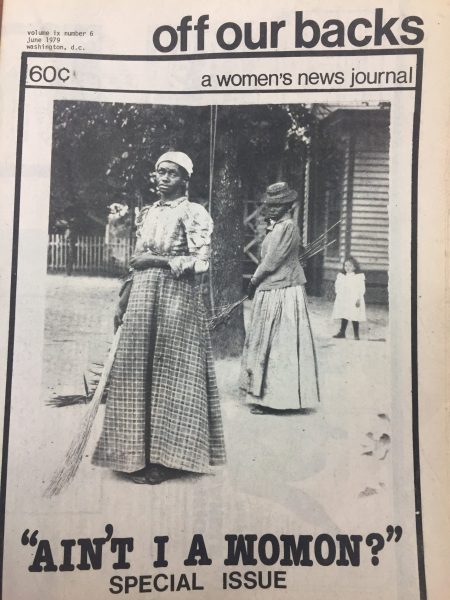
This special issue was produced by the Ain’t I a Woman Collective, a black feminist organization based in D.C.
The black women and feminists of the period did not believe their plights as black people living in America and as women living in America could be separated. They believed they could not progress as whole humans without both issues, in addition to class, which was often correlated with race, being addressed.
One of the important issues that black women said white feminists did not grasp was welfare. A much larger proportion of black women were in poverty than white women during this period. The U. S. Census (Current Population Survey and Annual Social and Economic Supplements data) from 1975 shows that 27.1 percent of black families were in poverty compared to 9.7 percent of all families. Those statistics become even more staggering when we look at poverty rates for single-female households. 50.1 percent of black families with a single mother were in poverty compared to 32.3 percent of all other single-female households.
Intersectionality hinges on the idea that people have a complex identity that is shaped by a variety of demographic and experiential factors such as race, class and education. Black women were dealing with a variety of issues and sources of oppression during this period that, evidently, many of the white leaders of the feminist movement did not see as falling in line with their goals.
In the winter of 1974, some of the “Off Our Backs” staff attended the first meeting of the National Black Feminist Organization (NBFO). The group’s mission was to “fight racism and sexism jointly.” “Off Our Backs'” coverage of the event acknowledged that black women have an ethos to speak about issues that white women are unable to assume: “While ‘Off Our Backs’ has never been vague about its commitment to cover the issues and to carry messages about them to feminists, only a group like NBFO deeply immersed in the survival struggles of low-income black sisters and their own experiences, can be a valid messenger and a forceful mover of these issues.”
The coverage of the event emphasized that racism has kept women systemically divided by making minority women feel they could either be black or a feminist. Unfortunately, the article is critical of the fact that that many speakers ranked racism over sexism in terms of which was a more pressing issue. This clearly displays that many white feminists could not grasp the fact that these women felt they needed to confront the systemic racism in the country in tandem with, and perhaps, some would argue, before, sexism.
The “Off Our Backs” article said that black men did not want black women to join the feminist movement and point out that male-dominated black media outlets like “Jet” or “Ebony” did not attend the meeting when many white feminist presses did. The writers also criticized black feminists for not utilizing these feminist outlets. This provides an interesting area to use to examine the underlying issues here – black women’s issues were not covered well by most white-dominated feminist media outlets, yet the writers of “Off Our Backs” suggest that these women were not reaching out to allow their stories to be told by these papers.
It is necessary to mention that there is a conspicuous lack of exclusively black feminist publications in Archives and Special Collections’ holdings at the Dodd Center. This may be attributable to gaps in the collection or there may have been few publications that served this specific interest group. It seems that black women’s issues were split between the feminist and black movements with some overlap in the media for each.
-Anna Zarra Aldrich
I smell a RAT
Anna Zarra Aldrich is majoring in English, political science and journalism at the University of Connecticut. Anna is a student writing intern studying historical feminist publications from the collections of Archives and Special Collections. The following guest post is one in a series to be published throughout the Spring 2018 semester.
In February of 1970 a terrorist group took over a prominent underground newspaper in New York.
The Women’s International Terrorist Conspiracy from Hell (W.I.T.C.H.), a direct-action political group, along with several other women’s groups and female “RAT” staffers took over the newspaper for what was supposed to be a single, token issue of the paper. The headline on this issue read, “Women Seize RAT! Sabotage Tales!”
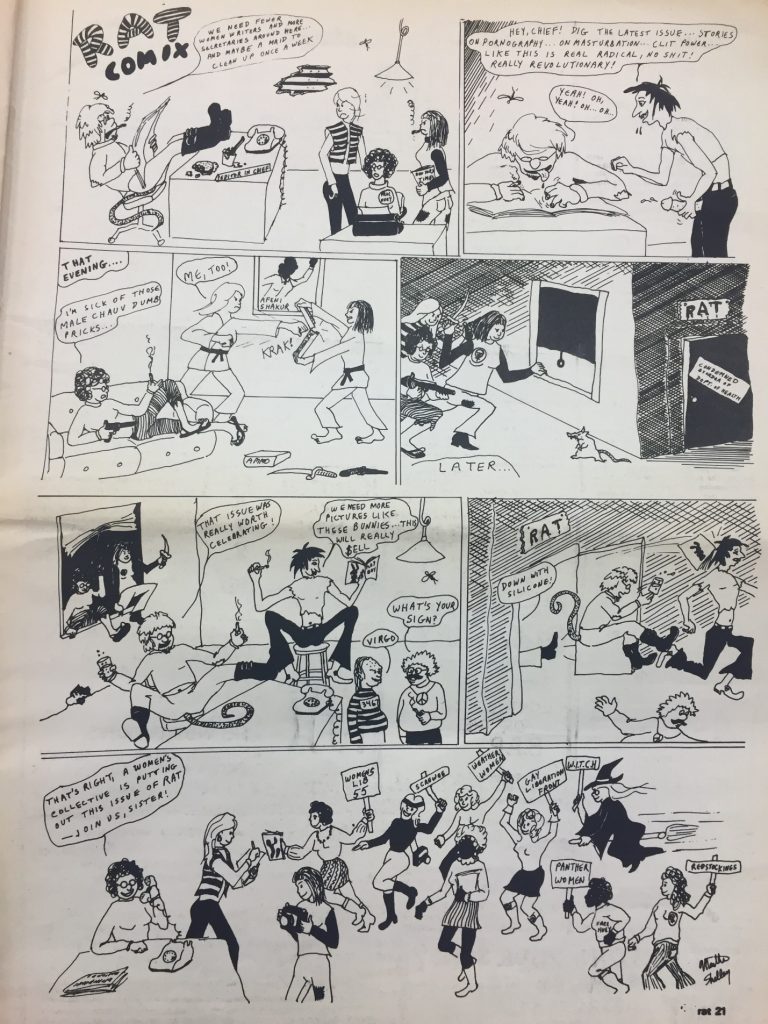
This comic, published in the women’s issue of RAT illustrates the takeover which was enabled by numerous women’s groups including W.I.T.C.H.
The women’s issue featured an essay by Robin Morgan, an American writer and noted feminist activist, titled “Goodbye to All That.” The essay sharply criticizes the advertisements using photos of women that bordered on pornographic and the continual exclusion of a feminist viewpoint from the paper.
“We have met the enemy and he’s our friend. And dangerous,” Morgan wrote.
Morgan’s article rallied against the white, male domination of the radical anti-war/anti-establishment movement. She said, “Goodbye, goodbye. To hell with the simplistic notion that automatic freedom for women – or nonwhite peoples – will come about zap! with the advent of a socialist revolution. Bullshit.”
Grievances against male radicals were common among feminist writers during this period. A pamphlet written by Andrea Dworkin in 1973 titled “Marx and Gandhi Were Liberals” stated that men permitted women to take part in their vision of the revolution so long as they kept their own demands moderated and subsumed within the male-dominated agenda.
“Liberal gestures of good will are made when we are shrill enough or when we are fashionable enough as long as we do not interfere with the ‘real revolution.’ Increasingly we understood that we are the real revolution,” Dworkin wrote.
The January 25-February 9, 1970 issue of “RAT,” the last one published by the male editorial staff, included numerous articles on pornography and masturbation. An article by Uncle Leon Gussow argued that pornography gives young men unrealistic views of sex and creates a separation between him and the act of sex. The women who worked at “RAT” took issue with how this topic was approached by the male staff; they believed this article, and the paper in general for quite some time, promoted pornography. Many women saw pornography as problematic as it often portrayed violence against women and this became a major issue in the women’s liberation movement.
The women also disliked the fact that the tongue-in-cheek titles that appeared on the masthead of each issue were often demeaning and stereotypical to women, referring to them as “princess” or “muffin purchaser.”
After the women of “RAT” published their issue they were loath to return control to the men who had been running the paper since its inception in 1968. So they didn’t.
In the next issue, the women still made up the entirety of the editorial staff, but some men came back temporarily as production staffers to ease the transition. In a letter to the readers, the editors said they were trying to “work it out” with the men. All male staff members were eventually asked to leave the paper and control remained in exclusively female hands.
A letter to the readers from former editor Paul Simon explained that after a “stormy” meeting between the men and women of the paper, it was decided that the paper would continue to be published by the women.
The takeover at “RAT” inspired women working at other papers across the country to follow suit. In the April 4, 1970 issue of “Vortex,” an underground paper published out of Lawrence, Kansas, W.I.T.C.H. wrote a letter to the paper saying, “you are a counterfeit left male-dominated cracked-glass-mirror reflection of the American nightmare.” The letter said the group was preparing to organize a boycott of the paper.
This letter was published in the issue of the paper following issue on the women’s liberation similar to the one that initiated the permanent takeover of “RAT.” In September of that same year, “Vortex” moved to a collective model of publication. This altered the existing editorial structure at the paper and gave women a larger say in its production beyond their single issue which, unfortunately is not available at the Dodd Center Archives.
“RAT” continued its coverage of issues like the Vietnam War and the trial of the 21 members of the Black Panther Party who were charged with coordinating attacks on a series of New York City buildings. However, the new editors made sure to make women’s issues and the accomplishments of female activists more prominent.
They featured letters from Mary Moylan, one of the Cantonsville Nine, a group of activists who burned draft files to protest the war. Moylan went underground, hiding from the authorities for a period and her letters about her time underground were published in “RAT” and other publications like the women-run “Off Our Backs.” “RAT” also featured articles about women’s role in the Israeli-Palestine conflict.
In March of 1971, the paper changed its name to the Women’s LibeRATion.
One thing the women sought to dissemble with their takeover was the hierarchical structure that had allowed men to squelch their voices for so long. This led them to establish a newsroom that was much more free-flowing and less rigidly structured. In a letter to the readers, the editors describe the RAT work collective’s meetings as “un-chaired and chaotic.”
The paper continued publishing with relative consistency through 1972 and then stopped abruptly for several months. Then, in April of that year, a newsletter came out.
The single printed sheet explained to readers that the fate of “RAT” was in limbo due to internal fractionalization. A group of six black gay women had seized control of the paper after airing their grievances against the white feminist viewpoint that had been almost exclusively featured by the paper.
The black women writing the article said there were too many fundamental misunderstandings between the white and third-world women in the movement to be reconciled into a cohesive vision in which all voices could be heard.

The letter published on the back cover of the single-sheet issue asked readers to respond with feedback and monetary donations to support the continuation of the publication
The newsletter closed with a request for feedback from readers, “Your responses will determine the outcome of the almost defunded ‘RAT;”. The paper also asked for monetary donations to help keep the presses running.
Unfortunately, it appears these women were unable to keep the paper afloat either due to a lack of interest or lack of funds.
The downfall of “RAT” showcases the lack of an understanding of the idea of intersectional feminism during this time. Perhaps it also demonstrates a lack of will on the part of white feminists to create connections with minority women and engage in meaningful dialogue to understand their issues. Minority voices were not generally included in the more-prominent feminist outlets, or if they were given a space, it was still through the good graces of white editorial staffs. This is an unfortunate truth that the feminist movement continues to grapple with today.
-Anna Zarra Aldrich
Aphradisiac
Anna Zarra Aldrich is majoring in English, political science and journalism at the University of Connecticut. She is a student writing intern studying historical feminist publications from the collections of Archives and Special Collections. The following guest post is one in a series to be published throughout the Spring 2018 semester.
During the 1960s and 1970s feminist writers established themselves with a distinct and demanding voice. In order to accomplish the feat of integrating a prominent female presence into the literary world, women created and utilized exclusively female publishing mediums. Women took to using alternative methods that allowed them to cultivate this unique literary culture outside the realm of the traditionally male-dominated publishing world.
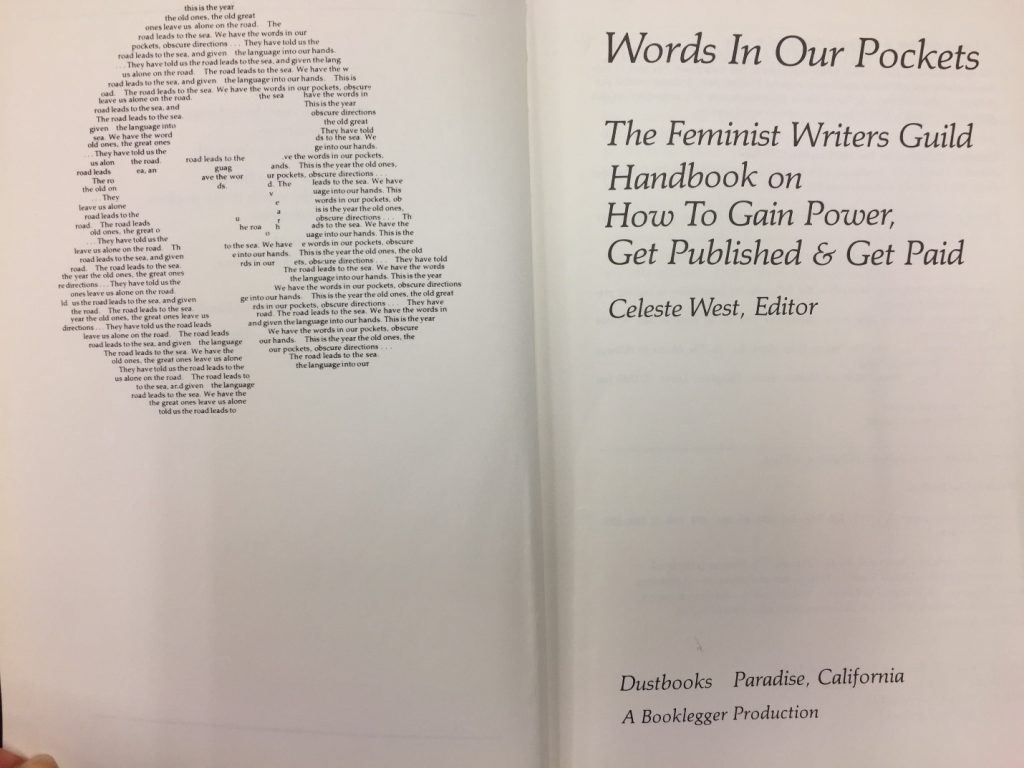 In 1985, noted librarian and author Celeste West published a book titled “Words in Our Pockets: The Feminist Writers’ Guild handbook on how to gain power, get published & get paid.” The book provided an in-depth look at the publishing world through a feminist lens and provided women with resources and options for alternative paths to publication.
In 1985, noted librarian and author Celeste West published a book titled “Words in Our Pockets: The Feminist Writers’ Guild handbook on how to gain power, get published & get paid.” The book provided an in-depth look at the publishing world through a feminist lens and provided women with resources and options for alternative paths to publication.
The cover of the book depicts a woman’s portrait composed of the words of a poem by Denise Levertov’s from which the book gets its title. It reads: “But for us the road/ unfurls itself, we count the/words in our pockets.”
The introduction of the book states that, “The present wave of feminism is…creating a women’s cultural renaissance, the first since matrifocal times. At last, we are building, in large numbers, our own literary tradition, finding our own audience, and from these, shaping a world view.”
This book emphasizes the fact that many of the most influential members of the movement have been writers who use the power of the written word to express the urgency and necessity of the changes they demanded.
West’s book begs the question: “Who among us can afford silence?” West wanted to encourage women to make their voices heard through the literary mire that was oversaturated with male perspectives.
The book goes through a basic how to process for practical elements of publication including writing proposals, making sense of the legal jargon in contracts and financing options. The book also deals with the sexism of the industry. The book provides advice on how to deal with people, namely powerful men, who refuse to take women writers seriously and list feminist publishers and a guide on self-publishing as a means to circumvent discouraging male publishers.
“You are a writer, not a wallflower. Why wait for some gentleman publisher to sweep you into his arms and carry you off to the Big House?” West proposes.
In an article published in the summer 1979 issue of “Chrysalis” magazine, West wrote “Book publishing, like all industries, is controlled by rich, white, heterosexual men. To retain this power, their books naturally reinstate status quo attitudes of privilege and discrimination.”
The article cites the figure that 70 percent of books published were produced by 3.3 percent of the over 6000 publishing houses that existed at the time. West calls independent, alternative press outlets “the slice of tomorrow.”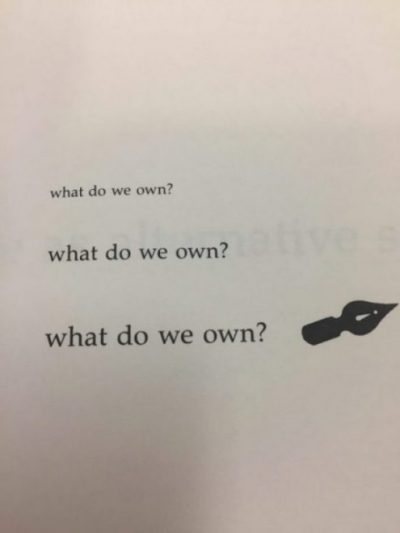
The book’s engagement with the challenges female writers faced showed that even as women encouraged each other to write, the established system often operated to keep them excluded. This created a space for female-run literary publications that provided a platform for women writers who were not welcomed into traditional literary circles.
“Aphra” was an feminist literary magazine published quarterly from 1969 to 1976 out of New York City. The magazine got its namesake from the pioneering English poet, playwright and author Aphra Behn (1640-1689) who was the first woman known to have earned her living by writing.
“Aphra’s” mission statement was “Free women thinking, doing, being.” In the preamble to their first edition, the editors state that the purpose of the magazine is to provide women with an outlet to express themselves: “We submit that one reason for the form of the current upsurge in feminism…is that the mass media provides such biased and commercially oriented material. The literary and entertainment scene are dominated by male stereotypes, male fantasies, male wish fulfillment, a male power structure,” echoing West’s complaints.
The magazine was a clear response to the male domination of the literary field in contemporary American society and historically. Each issue contained a collection of “Aphra-isms” which were quotes from feminist figures such as Mary Wollstonecraft, Sojourner Truth and more modern feminists like Kate Millet. The section also featured historical and modern examples of sexism from literature and the news.
“Aphra” published work from a variety of authors, including Margaret Atwood and Alice Walker, who each provided a unique take on feminist issues of the day yet they all had an underlying tone that was unapologetic and focused on confronting the problems they observed in society.
In a short story by one of the magazine’s editors, Elizabeth Fisher, titled “My Wife,” she explores the downside of the sexual revolution which allowed and encouraged women to enjoy the sensual pleasures of sex. The story is told from the perspective of a man who believes he has the honor of sexually awakening his future wife. The man becomes disenchanted with his wife soon after they are married and her body changes as a result of her pregnancies and their sex life naturally dwindles. The kicker of the story is the conclusion when the husband overhears his wife admitting to a friend that she faked every single orgasm he thought she had had with him. This sends the narrator into a devastating existential crisis as his fragile male sexual ego is absolutely destroyed.
“I look at the children. They’re my daughters, but they’re hers too. Will they, too, grow up to betray me and their husbands, a man’s whole raison d’etre?…There’s nothing left. How can I live now, how can I go on?”
This desperate conclusion to the story shows how a female writer revealed the negative side of the sexual revolution. Since women were now allowed to admit they enjoy sex, they were expected to. Despite this revolution in sexual philosophy and the growing availability of a variety of birth control methods, male views of sex remained chauvinistic and self-centered. The narrator displays a kind of toxic masculinity that created a culture in which women felt obligated to fake orgasms and feign pleasure. These women felt they had to play the role of the sexually liberated woman even when reality remained stalled in antiquated sexual attitudes that prioritized male sexuality and pleasure.
An unsigned editorial in the second issue of the magazine addresses the difficulties the second-wave feminist movement faces in terms of measurable accomplishments. The first iteration of the women’s movement in the early 20th century was focused primarily on women’s suffrage. The passage of the 19th amendment in 1920 was a clear victory for the movement and led to its dormancy for the next forty years. The goals of feminists in the 1960s, aside from fighting to achieve the passage of the Equal Rights Amendment, were geared toward largescale social change. The author of the editorial astutely observes that, “It is an aim which all too often proves illusory since you can’t legislate orgasm — produce it by fiat, despite all the promises which seem to say, ‘Let there be orgasm!’”
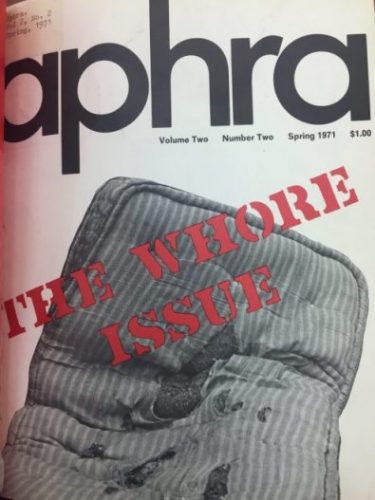 In the spring of 1971, “Aphra” had a special “Whore Issue”. This issue dealt with problems of women being condemned for sexual promiscuity as well as the exploitation of women as sex workers.
In the spring of 1971, “Aphra” had a special “Whore Issue”. This issue dealt with problems of women being condemned for sexual promiscuity as well as the exploitation of women as sex workers.
An editorial by Fisher argues that the problem with sex is that it has been made into a commodity. Women are defined by their sexual relationship with men as a wife, a mother, a mistress or a whore. Fisher writes that by viewing sex in these terms, female pleasure is devalued and the woman is transformed into a dehumanized sex object.
While “Aphra” was primarily a literary journal, through Fisher’s editorial leadership it engaged questions of the sexist nature of sex. Fisher also wrote repeatedly on the role of men in procreation, which had recently become optional given advancements in invitro fertilization.
A similarly satirical take on issues of sexual freedom can be found in a 1973 issue of another feminist literary magazine, “Velvet Glove.” A story by Susan Watkins follows a woman working in a pharmacy who is required to inquire if a customer is married before she is allowed to sell them contraception. The female protagonist asks her condescending male manager if people could not just easily lie and he tells her she must ask anyway in compliance with the law. The protagonist’s retort is to wonder if she should also be required to ask young women buying menstrual products if they’re 12-years old. This story is another example of satirical writing which was clearly a way feminists saw fit to combat the social ills they observed.
Feminist have long been thought of as humorless and in modern times many even refer to them as “feminazis.” While much of the work published in literary journals like “Aphra” and “Velvet Glove” is of a serious nature, it also provides women with a platform to express a brand of humor that would not have been well-received by a male audience.
Even “Words in our Pockets” participates in this emergence of a female comedic culture as the copyright information on the inside of their front cover warns readers that “a Surveillance MicroblastchipTM embedded in this spine will blow you to bits in the event of unauthorized copying.”
When women were writing to and for other women, they embraced the satirical and humorous side of the movement. Women could rarely do this publicly for fear of being dismissed as frivolous; but women’s publications provided women with an outlet for their special brand of ingroup feminist humor.
Women began working their way into the literary world earnestly and consciously during the 1960s and have not turned back since. In 1960 only 24 percent of the books that landed on the New York Times Bestseller List were written by women. That number fluctuated each year but never rose above 40 percent until 1992. Since then, the gender divide has been roughly equal, though never exceeding 50 percent. It is not a stretch to say that publications like the ones described here have helped establish the feminist literary tradition that has allowed modern female writers to have much more proportional representation in the field.
“Words in our Pockets” ends on a poignant and unmistakably optimistic note. The second to last page contains the words “The End.” When the reader turns the page, she reads: “The statement on the other side of this page is false.” And clearly, that latter statement was correct.
-Anna Zarra Aldrich
The Proper Sculpture: A Week with the Charles Olson Papers
The following guest post is by Stefanie Heine who was was awarded a Rose and Sigmund Strochlitz Travel Grant in 2017 to conduct research in Archives and Special Collections. Dr. Heine studied English, Philosophy and Comparative Literature at the University of Zürich. She was a Research and Teaching Assistant at the Department of Comparative Literature in Zurich. After completing her PhD (cf. Visible Words and Chromatic Pulse. Virginia Woolf’s Writing, Impressionist Painting, Maurice Blanchot’s Image. Wien: Turia + Kant, 2014), she started working on a post-doc project on the poetics of breathing and she is now a postdoctoral fellow at the University of Toronto (Centre for Comparative Literature).
“we are ourselves both the instrument of discovery and the instrument of definition”
“this instant, […] you on this instant, […] you, figuring it out, and acting, so”
– Charles Olson, Human Universe
Without my knowledge, the GPS of the car I rented at Boston Logan airport was set to “discovery route”. I drove for over three hours, red maple, black oak, sweet birch and white ash making me indifferent to the fact that map turned to maze.
I arrived at the University of Connecticut on the day of the solar eclipse. Caught in those first moments of archive fever, I probably would have forgotten about it, if my partner hadn’t texted me: “You should go out now.” When I did, I couldn’t see. Only for a few seconds the blaze yielded to a clear-cut sickle through the glasses a woman lent me in front of the Thomas J. Dodd Research Center.
These two scenes composing the mood of my arrival at the Charles Olson Research Collection kept determining my exploration of the archive, and they turned out to be instances where Olson’s paths crossed mine. On the one hand, they were points where my own research met Olson’ methods. “methodos […] turns out to be meta hodos […] the principle of—PATH”, “the way the path is known”, Olson explicates in a letter to Robert Creeley in June 1952 (152). The way the path is known involves the person on it and for Olson, research is inextricably linked to the experience of the individual who conducts it, in the very moment it is conducted. On the other hand, there are more specific correlations between what I encountered on the way to and through the archive and Olson’s methodological and poetological approaches. The title of a section of the Maximus Poems, “Each Night is No Loss, It is a daily eclipse, / by the Earth, of the Sun” (448) can be read in line with these approaches. The phenomenon of eclipse could be considered as something that happens on a continual basis when we do research and write: instances of blindness and sudden illumination reoccur, again and again. In an unpublished essay I came across in the archive, Olson explicitly comments on the overlaps of “blindness” and “recognition” in the process of literary production, the creation of poetic form: “A form does only disclose itself if a man does go blind.” (Form, no more than means, is caused) With his emphasis on the writer’s or researcher’s sensation of blindness (literary writing and scientific discovery are inextricably linked for him), Olson counteracts what he considers as the most dominate way in which knowledge is achieved, the ‘Western logos’, in which the rational mind at clear daylight engages in classification and abstraction. This method is what for Olson prevents an immediate involvement of the writer or researcher with their objects of discovery and destroys the “kinetics of the thing” focused on (“Projective Verse” 16). In the archive, the proximity to the new material as such prevented any critical distance for me. The massive amount of writing held in the Charles Olson Research Collection offers too much input to process straightaway; most of the time, I was in a haze, reading and copying as much as I could, assembling material to be ‘investigated’ later. But maybe the point where I was closest to ‘knowledge-bringing event[s]’ in Olson’s sense (he borrows that term from Maurice Merleau-Ponty, for example in A man’s life is a continual allegory) was in the archive itself.
One of these events particularly stands out: in one of Olson’s early notebooks from 1945, a passage on syntax caught my attention. Being aware that this must be one of Olson’s the very first written reflections on literary composition and one of the first attempts to formulate principles for his own writing, I was excited. But my enthusiasm was soon overshadowed by a banal fact: Olson’s handwriting, which needs some time to get used to in general, is specifically hard to decipher on these two pages of the tiny notebook covered densely with words in pencil. I was entering a domain where language becomes utterly private and is almost impenetrable because of its singularity. “Syntax is a key”, Olson writes – and it seemed to me at first sight that it would be denied to me to unlock the gate presented by Olson. “I have a hunch I allow too much of … into my syntax.” I was too curious about what he thought he allows too much of in his syntax to turn away from the passage. When I met Melissa Watterworth Batt on the next day, knowing her experience with Olson’s manuscripts, I asked her to help me with the passage. The collaborative effort turned out to be fruitful – in the process of thoroughly scrutinizing the text, one word after the other came to light. We turned the notebook around in our hands to change the angle so that a fresh perspective might change curves into letters and a magnifying glass helped to make visible what our eyes failed to see. We zoomed in and out digital images of the page on laptop and iPhone – lines turning into pixelated patches and then to a “b”, an “l”, an “o”. The last hitherto obscure word became legible when I was back in my hotel room in Vernon, and there it was:
I tend to think that I need to maintain a more natural syntax than the process of my thinking + feeling sometimes accomplishes. I have a hunch I allow too much of the complication of both to intrude into my syntax. Yet how to arrive at an objective language without changing the syntax? Nouns, verbs, and images are the answer (see Yeats or Pound for this). Actually, of course, all this is technical + the thing will come out of me as a poem. Otherwise, no. So I must continue + be led by my nose, willy-nilly. I have no choices. Hammer each step of the way. You have rid yourself of the orphic, a little. Continue to beat with the hammer to get the proper sculpture.
The proper sculpture – the image Olson uses to describe a poem in process ceased to be a metaphor when I had the deciphered passage in front of me. In fact, the whole process of deciphering echoed the activity of a stonecarver. Or, rather, the archeological experience with Mayan glyphs Olson describes in his letters to Robert Creeley in 1951. Tracking the shape of penciled lines was a sensual experience of words as things, graphite on paper, it was a physical engagement with Olson’s written material that may come close to what Olson perceived in Lerma while digging out the stones on which the glyphs are engraved, holding words in his hand as solid objects. The transformation of curves into letters and words I observed while deciphering allowed me to partake in a “kinetics of the thing”. I was involved in an act of paying attention to “what happens BETWEEN things”, which, according to Olson is one of the last “acts of liberation science has to offer” (“The Gate and the Center” 169). Between things: between the words on the page, between my eyes on the page and the digital image, between my eyes and Melissa’s.
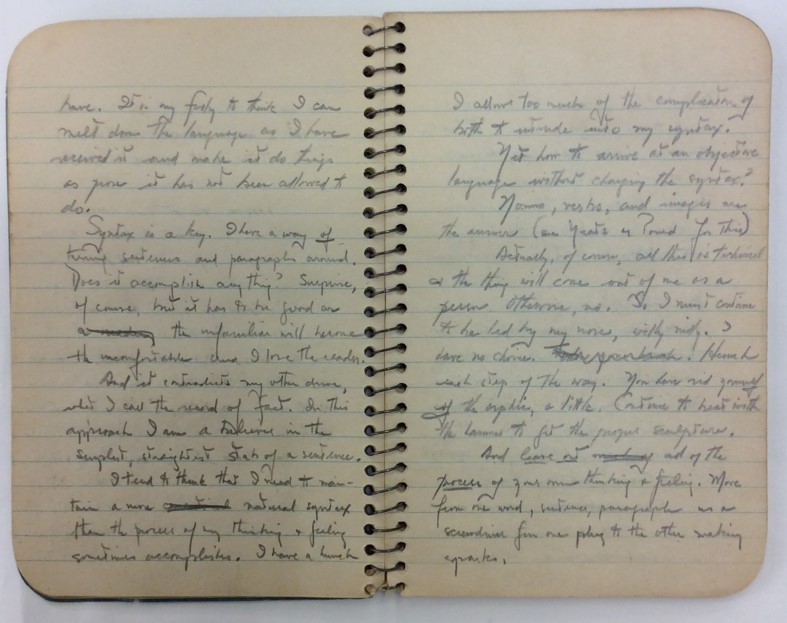
Washington Fall 1945 I. Charles Olson Research Collection. No. 55. October 25, 1945 – December 19, 1945
The process of deciphering is not the only way in which I experienced the archival material in its physicality. A preoccupation with Olson’s papers does not only involve investigating the contents of his thought. The writings archived in Storrs do not only occupy the mind, they are things to be experienced with all senses. The material dimension of his texts does not only become perceptible through the resistance caused by Olson’s handwriting – when the words’ meaning is interrupted by their particular shape. It is primarily the things Olson used to write on that strike the eye: besides notebooks, notepads and sheets of different size, colour and texture, and objects he found in front of him like a paper placemat, he scribbled notes between the printed words of flyers and booklets, even his passport.

The principle extrications and new coordinates now called for. Charles Olson Research Collection. Prose No. 40. Holograph/typescript. 8p. ca. September – December 1951
After this personal account of my “discovery route” through the Olson archive, a few words on the research project that led me to Storrs: In the first chapter of my planned book titled “Poetics of Breathing” I investigate how breath is discussed as a compositional principle in the context of the Black Mountain School and the Beat Generation. The focus is on concrete attempts to establish an embodied poetics of breathing. In this context, I explore how Olson sketches compositional principles based on breath in essays, poetological manifestoes, notes and letters about his own writing practice. The unpublished material I found at the Charles Olson Research Collection gives me further insights in the development of Olson’s poetics of breathing and the Rose and Sigmund Strochlitz Grant I was awarded enabled me to make important steps on the path towards my book.
-Stefanie Heine
Works Cited
Archival Material
Olson, Charles. A man’s life is a continual allegory. Charles Olson Research Collection, University of Connecticut. Prose No. 136. Typescript. 4p. December 26-27, 1963.
Olson, Charles. Olson’s passport. Charles Olson Research Collection, University of Connecticut. Annotated. No. 64. 1957.
Olson, Charles. The principle extrications and new coordinates now called for. Charles Olson Research Collection, University of Connecticut. Prose No. 40. Holograph/typescript. 8p. ca. September – December 1951.
Olson, Charles. Washington Fall 1945 I. Charles Olson Research Collection, University of Connecticut. No. 55. October 25, 1945 – December 19, 1945.
Olson, Charles. You can’t use words as ideas. Charles Olson Research Collection, University of Connecticut. Holograph. October 1964.
Published Material
Olson, Charles and Robert Creeley. Charles Olson & Robert Creeley: The Complete Correspondence. Volume 10. Ed. Richard Blevins. Santa Rosa: Black Sparrow Press, 1996.
Olson, Charles. “Human Universe”. Collected Prose. Ed. Donald Allen and Benjamin Friedlander. Berkeley: University of California Press. 1997, 155-166.
Olson, Charles. “Projective Verse”. Selected Writings. Ed. Robert Creeley. New York: New Directions, 1966.
Olson, Charles. The Gate and the Center. Collected Prose. Ed. Donald Allen and Benjamin Friedlander. Berkeley: University of California Press. 1997. 168-173.
Olson, Charles. The Maximus Poems. Ed. George F. Butterick. Berkeley: University of California Press, 1983.
A Tale Of Two Art Journals
Anna Zarra Aldrich is majoring in English, political science and journalism at the University of Connecticut. She is a student writing intern studying historical feminist publications from the collections of Archives and Special Collections. The following guest post is one of a series to be published throughout the Spring 2018 semester.
The second advent of the feminist movement that washed over American society in the 1960s and 1970s like a tidal wave emphasized a pervasive message of empowerment which manifested in a variety of periodicals during this period, including art journals.
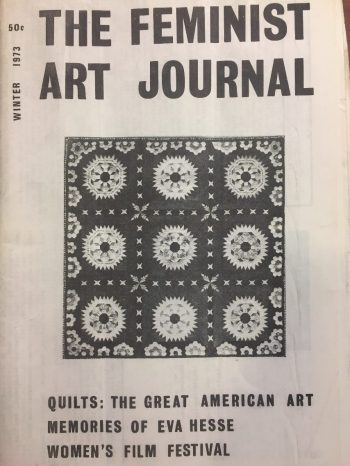 Women had largely been excluded from the world of fine art for centuries as geniuses like Michelangelo, Van Gogh, Picasso, Dali and Monet were celebrated and revered while their female contemporaries, such as Georgia O’Keefe or Frida Kahlo, were few and far between as their talent went largely unencouraged and unrewarded.
Women had largely been excluded from the world of fine art for centuries as geniuses like Michelangelo, Van Gogh, Picasso, Dali and Monet were celebrated and revered while their female contemporaries, such as Georgia O’Keefe or Frida Kahlo, were few and far between as their talent went largely unencouraged and unrewarded.
“The Feminist Art Journal” was published quarterly from 1972 to 1977 out of Brooklyn, New York by Feminist Art Journal Inc. One of the early editions of the journal from 1973 addresses the idea that women have created art for the centuries during which they were strictly confined to the home. An article titled: “Quilts: The Great American Art,” discusses how quilts, tapestries and other home décor have acted as mediums of female artistic expression that have historically been disregarded by men as mere frivolous decorations. The article states that, “Women have always made art. But for most women, the arts highest valued by male society have been closed to them for just that reason.”
An editorial from the same issue emphasizes the need of women to “rediscover their own history.” One of the primary aims of “The Feminist Art Journal” was to reclaim women’s place in art history through articles such as the one on quilts and by discussing issues of female representation in classical art. An intriguing article on Marie De Medici from the Summer 1977 issue explores how the powerful Florentine heir-turned-French-monarch commissioned portraits of herself and her life accomplishments like those that were traditionally done for prominent males of the period. Medici also pointedly decorated her palace with statues of great women like Saint Bathilde and George Sand. The article emphasizes how Marie de Medici understood the power of art as a political statement,  underscoring another one of the journal’s core messages: art is political.
underscoring another one of the journal’s core messages: art is political.
Interestingly, a short-lived lesbian feminist journal published from 1973 to 1975, the “Amazon Quarterly: A Lesbian-Feminist Art Journal” expressed a much different viewpoint from “The Feminist Art Journal”. “Amazon Quarterly” was published from the other side of the country, in Oakland, California by Amazon Press. It should be noted that both of these journals were published independently, sustained by revenue from subscriptions, single issue sales and advertisements. Both journals also had exclusively female editors.
The “Amazon Quarterly” commended women’s lack of participation in the male-dominated art world, in which they were routinely objectified in the works of male artists, rather than seeking to place women’s accomplishments within this patriarchal frame work.
Both “The Feminist Art Journal” and “Amazon Quarterly” promoted and provided a platform for female artists to share their literature, poetry, drawings, photography. However, “Amazon Quarterly” made promoting the art of women, specifically lesbians, its primary artistic goal, rather than engaging in discussions of history.
The division in purpose and ideology of these two journals which served, broadly, the same role, reflected a deeper division in the feminist movement between lesbians and straight women. Some lesbians believed women could not fully participate in the true revolution of the feminist movement so long as they were still sexually involved with their male oppressors, a radical idea that is discussed in articles published in the journal.
In an article, “Distinctions: The Circle Game” from the February 1973 issue of
“Amazon Quarterly” written by one of the editors, Laurel Galana, whose byline is simply a familiar: Laurel, explores these divisions within the movement.
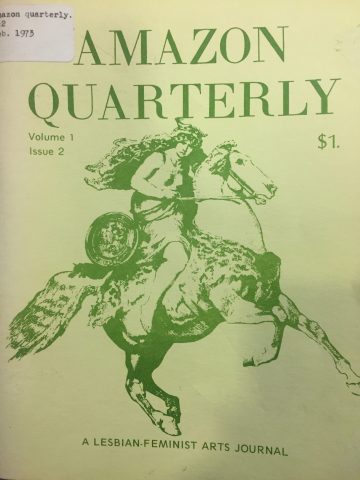 Laurel breaks down the group of women who are feminists into increasingly small subcultures from lesbians to “new lesbians” to dykes. The “new lesbians” Laurel describes had several verboten relations including those with men and straight women, whom they viewed as “men’s women.”
Laurel breaks down the group of women who are feminists into increasingly small subcultures from lesbians to “new lesbians” to dykes. The “new lesbians” Laurel describes had several verboten relations including those with men and straight women, whom they viewed as “men’s women.”
Laurel herself abides by these taboos, she explains, “My energy, my time, my sisterly love was indirectly useful to the male for keeping his woman content. And secondly, I decided not to relate to straight women because they already had made a choice which did not include me – that is all of me.”
The piece goes on to criticize lesbians who distinguish themselves based on class, believing that such internal divisions will only cause the movement to fracture and be less effective. She seems to miss the irony of the fact that she believes lesbians should not associate with straight feminists and form a united front of all feminist women.
Much of the art and especially the literature published in the journal reflected the fact that “Amazon Quarterly” branded itself as a periodical that intended to cater specifically to lesbian women. Many of the pieces published in the journal deal with tales and the feelings associated with homosexual awakenings and attraction. The publication had an entire issue dedicated to the topic of sexuality as their swan song before shutting down in 1977.
While the journal ceased publication in 1977, the editors went on to run Bluestocking Books, a publishing house which published a few novels including “The Violent Sex” by Laurel Holliday. Holliday’s book confronted the evolution of masculine sexuality and behavior that has led to the sexual and social oppression of women.
 Despite their differences, both these journals considered art in an expansive sense, including all forms of visual and literary art, and stressed the importance of the inclusion of the female perspective in them.
Despite their differences, both these journals considered art in an expansive sense, including all forms of visual and literary art, and stressed the importance of the inclusion of the female perspective in them.
While these two journals had different audiences and somewhat different goals, they both served to underscore the important idea that art is political, and that women had to understand how they could use any and all forms of art to express their ideas and achieve their objectives.
The art of many female artists of the period, during which feminist art truly began to flourish and find its foothold, was clearly in line with this philosophy. Some notable works include Judy Chicago’s “The Dinner Party,” which portrays a dinner party of 39 notable historical women, and Hannah Wilke’s avant garde “Starification Object Series,” a series of photographs for which she covered her body with wads of gum folded to resemble female genitalia.
These two journals and the art they supported show how women utilized the arts to promote the feminist agenda as they worked toward achieving social and political equality despite divisions within the movement.
In a 1977 interview published in “Chrysalis” magazine, Chicago commented on the value of art to the feminist movement.
“Art is particularly important for women and can catapult women into a different realm of consciousness by symbolizing and objectifying our experience. That expression, that impulse, has such potential power, and it is that power that society tries to contain by trivializing, by repressing, by suppressing the art impulse,” Chicago said. “As long as women participate in that process, we will never be able to realize our full creative potential. We must bust out of that, just absolutely bust out of that and reclaim art as the basic outpouring of the human spirit and pour out our songs and all our feelings and all our beliefs and all our visions in a way that everyone can hear.”
-Anna Zarra Aldrich
In Search of Walt Dropo
Image
The following is a guest blog post by Rebecca A.R. Edwards, Professor in the Department of History at Rochester Institute of Technology. Dr. Edwards was recently awarded a Rose and Sigmund Strochlitz Travel Grant to conduct research in Archives and Special Collections. Her research supports a book project tentatively titled Play Ball: Sport, Community, and Memory in Connecticut,” a microhistory that “utilizes local sports history to explore the formation of community identity, social capital, and public memory.”
Sometimes, historical projects get personal. I am a historian at the Rochester Institute of Technology in Rochester, New York. I teach, among other things, the history of baseball and have a long-standing interest in sports history. I could say that my current project is a sports history, and that would be true, but it is also a family history. When I was a girl, growing up in southeastern Connecticut, my paternal grandfather, Danny Rourke, was famous. He played both semi-professional basketball and semi-professional baseball in the state, from 1935-1955. In this way, he was like so many other men in Connecticut in those years, as I have been discovering in the course of my research for a book on this lost sporting world of eastern Connecticut.
We have lost the category of “semi-professional athlete” today. These were men who played organized, competitive sports, largely without long-term professional aspirations. Their basketball was not played to lead to them to the NBA; their baseball was not a road to the MLB. It was an end in itself. Forrest C. ‘Phog’ Allen, the celebrated University of Kansas basketball coach, argued that their play was, in fact, professional. In 1937, he wrote, “The professional—paid or unpaid—plays to win at any cost. Herein lies the significant difference between amateurism and professionalism, whether it be independent or collegiate. When competition becomes a business, it becomes professional. By such interpretation professionalism is not determined by the acceptance of money. The tenor of most independent teams who play outside schedules is professional in spirit, for their stress is on winning and not on the sport for the sport’s sake.”(i) He continued, “The universally accepted definition for a professional player is one who receives compensation for athletic skill or knowledge. If we interpret ‘compensation’ to mean either fame or money or its equivalent, this definition holds.”(ii)
In this way, my work seeks to recover the hidden history of these local professionals. These independent teams that my grandfather played on no longer exist, teams like Pep’s Flashes, the Shymas, and the Danielson Elks. And yet these were teams that attracted hundreds of fans, garnered lots of local press coverage, and brought their players lasting fame. And sometimes, though comparatively rarely, they produced a professional athlete from their ranks.
My research brought me into contact with what one might call the pre-history of one of those athletes. He is pictured in the photograph, from the Norwich Bulletin of 31 March 1941, below. 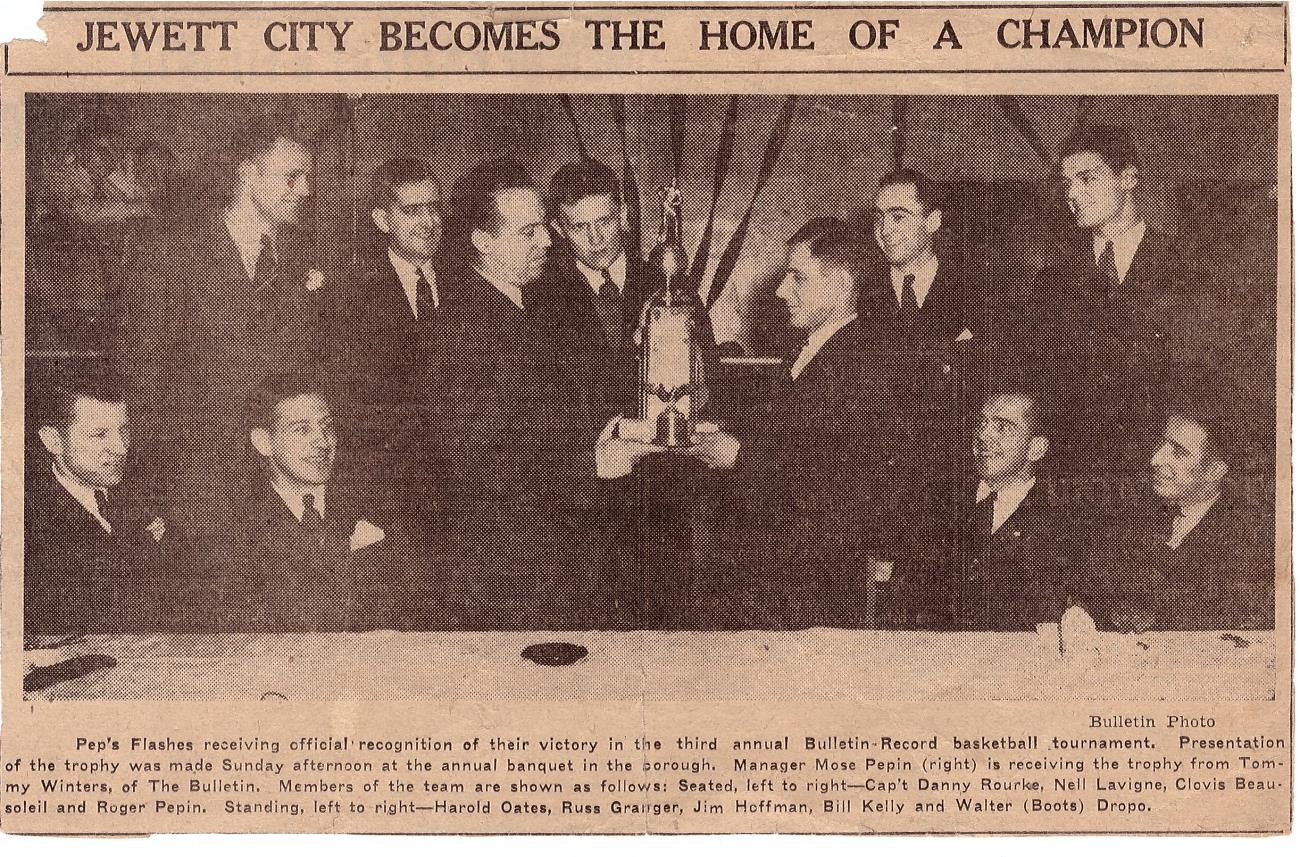 He really is famous. Find him yet? He is a very young Walt Dropo, then in his senior year of high school. He is in the back row, all the way to the right. Dropo was the youngest member of Pep’s Flashes, pictured here after winning the Norwich Bulletin-Record basketball tournament.
He really is famous. Find him yet? He is a very young Walt Dropo, then in his senior year of high school. He is in the back row, all the way to the right. Dropo was the youngest member of Pep’s Flashes, pictured here after winning the Norwich Bulletin-Record basketball tournament.
The captain of the team was my grandfather, seated at the far left. The Sunday sports page announced the news of their victory. “Pep’s Flashes Win Bulletin-Record Tournament, 48-37; Jimmy Hoffman and Danny Rourke Are the Stars.” The game was played before a “packed house of about 450 noisy customers…making it the third night that the games were played before a capacity audience.” Pep’s led the entire way, and though the “game was never close enough to get the fans steamed up…it was bruising, tough basketball from start to finish and nobody was disappointed.” The Norwich Record praised the team, saying, “Pep’s really looked the part of champions. Their passing and their shooting was a beautiful thing to watch and were altogether too classy” for their opponents, the Doco Eagles of Norwich. Hoffman was the game’s high scorer, while Rourke played “a marvelous floor game.” They had help from ‘Boots’ Dropo, who contributed nine points.(iii)
‘Boots’ Dropo, as he was then known, would go on from Plainfield High School to attend the University of Connecticut, as probably everyone already knows. Upon Dropo’s death in 2010, Coach Dee Rowe called him “the greatest all-around athlete this school has ever seen.” Dropo played football, basketball, and baseball for the Huskies. He was drafted by the Chicago Bears in the 9th round of the 1946 NFL draft. He was drafted in the first round of the 1947 BAA (Basketball Association of America, a pro-league pre-NBA) draft by the Providence Steamrollers. But he turned it all down to sign with the Red Sox organization in 1947.
In 1950, Walt Dropo was the American League Rookie of the Year, the first Red Sox to be named Rookie of the Year. He finished sixth in the AL MVP race. His .583 slugging percentage that year was second only to Joe DiMaggio (.585). “New England was full of Walt Dropos then,” Bill Reynolds writes, “small town kids who stole the hearts of their communities because of the way they played this New Game.”(iv) But that was still ahead of him. As late as 1946, you could have seen Walt Dropo playing basketball in a 200 seat auditorium in southeastern Connecticut with my grandfather.
By then they were both playing for the Shymas, who would also win the Norwich Bulletin-Record title. Dropo is seen here, in the semi-finals of the tournament.
The press coverage noted that Dropo and Rourke were key members of the team. “The Shyma club five of Taftville steamrolled to a 65 to 49 victory over the Windham Packards of Willimantic at the Norton Gym Saturday night to win the eighth annual Norwich Bulletin-Record basketball tournament before a capacity crowd of better than 600 fans….The Packards held the lead twice in the opening minutes of play, 2 to 0 and 4 to 2, but after that point they didn’t stand a chance as the Villagers swept down the floor time and again using the height of MacDonald and Walt Dropo and the floor work of Bill Kelly and Danny Rourke to great advantage. Besides giving a brilliant offensive exhibition throughout the contest, the Shyma put up a tight defense that the Willimantic combination had plenty of trouble cracking.”v Another account concluded that, in winning the tournament, the Shyma had demonstrated that they were “the outstanding hoop combination in eastern Connecticut during the past year.”(vi)
Dropo left for the Red Sox farm system the following year, in 1947. But he left having already played for two different championship basketball teams in Connecticut. As we remember his sports history today, we largely assume it starts with the Red Sox. His time in college sports is seen as a prelude to his professional career. My work allows me to see that he brought a champion’s play to UConn with him. He had been playing alongside semi-pro athletes since he was in high school. That was the drive he brought with him to Storrs.
The distance between the professional world of sports that Dropo would enter and the semi-professional levels of sport he was leaving behind was not very wide. Professionals were a part of their local communities then and semi-professionals were treated with much the same reverence and respect. October 14, 1950, was Walt Dropo Day in his hometown of Moosup, Connecticut. Dropo came into town with a barnstorming baseball team, the Birdie Tebbett’s All-Stars. George ‘Birdie’ Tebbett’s was a catcher with the Red Sox. Also barnstorming with Tebbett’s team that fall were Phil Rizzuto and Johnny Pesky.
They faced a home team, put together for the occasion, called the Connecticut All-Stars. Walt’s brother, Milt Dropo, himself a star athlete at the University of Connecticut, managed the All-Stars. Playing for them in right field was Danny Rourke. He was at that point playing for the New London Raiders in the Class B Colonial League, an effort to revive minor league baseball in southern New England. The original Colonial League had folded in 1915. This Colonial League was formed for the 1947 season; its last season was 1950. Walt Dropo Day was the last time that Dropo and Rourke took a field together.
Dropo’s career brought him to the MLB. Rourke’s career ended in Class B. Yet, the two men shared an athletic journey together that dated back to 1941. My grandfather is still remembered in some circles in southeastern Connecticut today, where I still sometimes meet old fans who call me “Danny Rourke’s granddaughter.” So I know sporting memories can be long. I had wondered, as I came to the Archives to search for images of Dropo’s college career, how well he was remembered on campus today. I worried a bit as the young archivist, whose name will remain unmentioned to protect the guilty, admitted that he had never heard of him until I started asking for files to be pulled. (He was brave to admit that to me and he was otherwise a perfectly nice professional, just to be clear.)
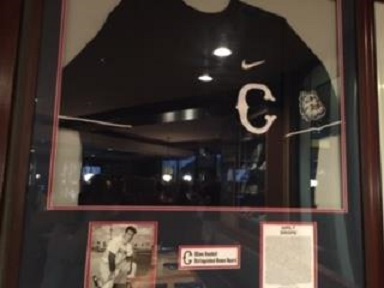 I was worried for nothing. As I settled into the Nathan Hale Hotel, I stopped at their pub for a beer, after a long day in the archives. I glanced over my head and found that I had taken a seat under Walt Dropo.
I was worried for nothing. As I settled into the Nathan Hale Hotel, I stopped at their pub for a beer, after a long day in the archives. I glanced over my head and found that I had taken a seat under Walt Dropo.
‘Boots’ Dropo. Still here, after all these years.
– Rebecca A.R. Edwards
Notes:
i Forrest C. Allen, Better Basketball: Technique, Tactics, and Tales (New York: McGraw-Hill, 1937), 7. ‘Phog’ Allen coached at Kansas from 1919-1956. He coached the Jayhawks to victory in the NCAA tourney in 1952, the same year that he coached the Olympic basketball team to a gold medal at the Helsinki games. He was inducted into the Basketball Hall of Fame in 1959.
ii Allen, 8.
iii All coverage from “Third Annual Bulletin Record Tourney.” Undated clipping. Potts family scrapbook.
iv Reynolds, Our Game, 7.
v “Shymas Take Bulletin-Record Tourney With 65-49 Win,” Norwich Record (March 31, 1946), 13. From Rourke family scrapbook.
vi “Bulletin Record Tournament Won By Shyma Club.” Undated press clipping. Rourke family scrapbook.
Harry Allard Is Missing! Collaborations of James Marshall and Harry Allard in the Northeast Children’s Literature Collection
The following guest post is by Jerrold Connors, an award-winning application developer, writer and children’s book author and illustrator from California. He was recently awarded the James Marshall Fellowship to pursue a picture book project based on Harry Allard’s Miss Nelson stories. The James Marshall Fellowship encourages the use of unique materials in the Northeast Children’s Literature Collection and provides financial support to authors and illustrators for travel to University of Connecticut’s Archives and Special Collections to conduct their research.
James Marshall, considered by Maurice Sendak to be one of the wittiest and most genuine children’s book author-illustrators, created the popular George and Martha stories, the charming Fox readers and the everlasting Miss Nelson picture books. He wrote and illustrated most of his stories himself, collaborated on several others with his friend and co-author Harry Allard, and illustrated the works of a few others. Marshall published upwards of 80 books from 1967 until 1992 when he died, aged 50, from AIDS. Though awarded few professional honors, Marshall is considered by many as one of the picture book greats—his works are held alongside those of Maurice Sendak and Arnold Lobel (with whom Marshall shared close friendships) as classics.
Despite growing up an avid reader in the early 1980s, I have no memories of reading any James Marshall books. It was only later, as a teenager reading to my nephew and niece, that I would discover the Miss Nelson books. And it was much later as a young adult reading picture books for my own enjoyment that I would discover George and Martha. I became a confirmed James Marshall fan and sought to find as many of his works as I could. I can think of very few creators whose entire body of work—unmistakable for its sense of fun, economy of language, subtle play between words and illustration and great respect for his young audience—I hold in higher regard.
Relatively little has been written about Marshall’s life and works but I have tracked down what I could and have come to consider myself something of a Marshall expert, so it was with great surprise and interest that I discovered a fourth Miss Nelson book, Miss Nelson Gets a Telephone Call, written, illustrated and self-published by Harry Allard in 2014, twenty two years after James Marshall’s death.
Miss Nelson Gets a Telephone Call is a peculiar work. It features all the Miss Nelson standards: a kind teacher, a befuddled principal, an elementary school setting, and a mystery surrounding a secret identity (the hallmark of the Miss Nelson series). But it also has an enormous cast of characters, a generous amount of exposition, a bizarre wordiness (gothic adjectives such as graustarkian, eldritch and stygian abound) and a distinctly creepy tone. And it is missing, notably, any children.
All these facts made me wonder how similar Miss Nelson Gets a Telephone Call is (if at all) to the original Miss Nelson trilogy. It’s a known fact that James Marshall heavily edited the authors’ texts that passed his drawing table (an unusual practice for an illustrator) but I wanted to know just how far Marshall went in shaping Allard’s manuscripts into the illustrated stories we have come to know. The books credited to Marshall and Allard are nearly identical in voice, pacing and humor to those credited solely to Marshall. So much so that it has even been suggested that Harry Allard might have been an invention, like Marshall’s “cousin” Edward Marshall, to serve as a pseudonym. While this would be wholly appropriate given the Miss Nelson tradition of dual-identity and disguise, it is not true. Harry Allard was a real person.
The two became acquainted at Trinity College in San Antonio, Texas where Allard taught French and Marshall was an undergraduate. An academic, Allard held a Masters degree and PhD in French from Northwestern and Yale. He was an admirer of French illustrators and drew and sketched as a hobby and in this sense found a kindred spirit in the artistically minded Marshall. They collaborated on a few picture books with Allard credited as author and James Marshall as illustrator before developing the character of Miss Nelson. As the story goes, Allard called Marshall at three in the morning and said “Miss Nelson is missing!” This bizarre non sequitur became the seed that would grow into three books about the teacher and her class.
The Northeast Children’s Literature Collection holds a rich and rewarding amount of materials related to the working relationship between James Marshall and Harry Allard. Of those materials related to the Miss Nelson book, the most complete were those for the second Miss Nelson book Marshall and Allard worked on together, Miss Nelson Is Back.
Miss Nelson Is Back: In the collection in Archives and Special Collections at the University of Connecticut is a series of dummies for Miss Nelson Is Back. The earliest of these dummies hints at what must have been Harry Allard’s original manuscript for this story. The story opens with Miss Nelson having to leave her class for a tonsillectomy. Filling in for her is a new character, Mr. Otis Delancey, a well-intentioned if inexperienced substitute teacher. The kids of Room 207 are more than ready to take advantage of him. Rounding out the cast is Miss Gomez, the school’s secretary, Detective McSmogg (a private investigator from the first Miss Nelson book, this time acting as a truant officer), and Mother Judkins, “special investigator” for the Board of Education.
With all these characters, the strictest substitute teacher in the world, Viola Swamp (the true star of the Miss Nelson books), gets very little screen time; in fact, her appearance is gratuitous. There is none of the guessing and second-guessing of double identities that made the first Miss Nelson book so much fun.
Looking through the collection of dummies and storyboards, I saw that within two drafts Marshall had put Harry Allard’s story through its paces, trimming the number of characters to a splendid few, namely, Principal Blandsworth, Miss Nelson, Viola Swamp and, of course, the kids of Room 207. The greatest fun in the story—the kids impersonating Miss Nelson in a terribly obvious and obviously terrible disguise—had been fully fleshed out and the text had been trimmed to nearly what would appear in the final printed version.
The edits on these dummies are all executed in Marshall’s distinct handwriting. Entire sections have been cut, others invented on the fly, hastily scribbled in between and alongside blocks of discarded text. Editing happens not just of Allard’s work but also of Marshall’s own. Marshall writes several versions of the line “So this is your little game?”, trying “What is this?” and settling on “So that’s your little game!” (In method it is very similar to a book done entirely by Marshall alone, The Cut Ups Carry On, which also exists in the archives and is splendidly detailed by Sandra Horning in her blog entry here.
Tracking changes through these drafts, it is very clear that what would appear as the final version of Miss Nelson Is Back was very much a Marshall story. For his part, Allard must have been okay with Marshall’s reworking of his script. Miss Nelson Is Back was their ninth book together, their second Miss Nelson book and they would go on to do another. I noticed also that Marshall sought to preserve some of Allard’s inventions through his drafts. Otis Delancey survived the transition from first draft to a storyboard before he was cut.
Miss Nelson Has a Field Day: The first pages of the dummy for Miss Nelson Has a Field Day* (Marshall and Allard’s third Miss Nelson book) is a combination of pencil illustrations with pasted down clippings from a typewritten manuscript. Whether or not the manuscript came directly, unedited, from Allard is unknown, but some clues indicate that it did. For one, the school in this story is named “Alice J. Gomez Elementary.” According to Marshall’s partner William Gray, Allard could become fixated on certain details such as odd words or funny names—that he would bring Miss Gomez back to the Miss Nelson universe seems in keeping with this habit. And, as in Miss Nelson Is Back, Allard has attempted to enlarge the faculty, this time with Miss Witherspoon, the cheer squad coach.
Eight pages into this dummy Marshall begins composing the pages by typing directly onto his drawing paper. A few pages beyond that and Marshall begins writing in his distinct hand, using shorthand to get his ideas quickly onto the paper as they occur to him. As with Miss Nelson Is Back, Marshall appears to be inventing on the fly, using this stage of his process to both trim and flesh out the story and ultimately make it his own.
*footnote: Holding the original cover concept for Miss Nelson Has a Field Day up to the light revealed that the working titles to this story were at one point Miss Nelson Tackles Trouble and Miss Nelson’s Secret Play.
Miss Nelson Takes a Back Seat: The collection also held a three page typewritten manuscript by Allard for an unpublished story titled Miss Nelson Takes a Back Seat. Dated 1989, this story expands Horace B. Smedley Elementary’s world to include a school bus service, an appropriate enough story device, but there is little else in the way of character or plot. The entire story is mainly a vehicle for some gags about members of a circus sideshow.

“Better watch your ‘P’s’ and ‘Q’s’’ , kids,” the midget threatened, brandishing his bull whip.”
Typewritten draft by Harry Allard, Miss Nelson Takes a Back Seat
There are no marks by Marshall on this document, and no evidence I could find in the abundant collection of sketchbooks (used often for brainstorming and testing story ideas) that he ran with the idea. Whether this was because Marshall at this point in his career was focusing on retelling fairytales or because he felt the Miss Nelson adventures had been played out is unknown. Although not a trilogy in a strict storytelling sense, the three Miss Nelson books form a tidy whole. Miss Nelson Takes a Back Seat doesn’t add anything to the Miss Nelson world.
Miss Nelson Is Missing!: From the previous examples, it is obvious that the majority of work that shaped the Miss Nelson books into what the public has come to know was executed by Marshall. This isn’t to say that Marshall didn’t value Allard’s contribution. Allard was a brainstorming partner, a writer who could turn out pages of script allowing Marshall to indulge in editing, evidenced many times in the collection as one of Marshall’s great strengths.
Late in my research I discovered a single page near the back of one of James Marshall’s sketchbooks. This book, sitting nondescriptly in the middle of Box 20, held a cover concept sketch for Miss Nelson Is Missing! Dated July 27, 1976, the sketch would have been made about one year before the first Miss Nelson book was to be published. At the top of the page Marshall had written “Written by James Marshall and Harry Allard”.
He then drew a double headed arrow to transpose his and Allard’s name to give Allard top billing. Eventually the cover page would remove the “written by” and “illustrated by” lines and feature the two names as collaborators with Allard’s name featured generously at the top of the page.
But despite the vast source of materials related to the Marshall/Allard collaborations, it was a very small thing that most informed my understanding of their relationship. In the seventeen minute James Marshall In His Studio video (one in a series produced by Weston Woods/Scholastic to introduce authors to their audience) Marshall speaks directly to the camera, explaining his process in creating picture books. In talking about where his ideas come from, Marshall describes the infamous 3am phone call from Allard. I’ve alway read the line “Miss Nelson is missing!” as an exuberant, even manic, exclamation on Allard’s part. But as Marshall tells the story (at the nine and half minute mark if you should ever be so lucky to find a copy of this recording) it is far more nuanced. Marshall does an impression of Allard’s voice. It is theatrical, a little affected, mysterious. It’s done with a smile and, clearly, affection for his friend.
Marshall appreciated in Allard all those things I found peculiar. His eccentricities delighted Marshall. What’s more, Allard’s inspirations—whether they ultimately served to chart the inappropriate, or uncover the promising—informed Marshall’s talents. Given the amount of work Marshall put into their collaboration, that he would give his friend top billing is testimony to Marshall’s generosity. But it would be shortsighted to consider it charity. Marshall truly valued his partnership with Allard. Like Miss Nelson and Viola Swamp, in this story one could not have existed without the other. If Harry Allard were missing, so too would be missing these three books.
On Charles Olson: poetics and / as pedagogy
Image
Dr. Michael Kindellan is a Vice Chancellor’s Fellow at the University of Sheffield, UK. He has published research articles on several 19th and 20th century Anglo-American poets, and has recently completed a book on Ezra Pound’s late cantos (to be published in September by Bloomsbury). Made possible by a generous a Strochlitz Travel Grant, in January he travelled to the Archives and Special Collections at the Dodd Research Center to consult the Charles Olson Research Collection, along with other, related collections, such as the Ed Dorn, John Wieners, Michael Rumaker, Fielding Dawson and Ann Charters Papers. This trip marks the beginning of work on his new project, tentatively called “Present Knowledge: Charles Olson and the Poetics of Pedagogy”.
I have been meaning to begin this project since late 2011, when I was first awarded a Strochlitz Travel Grant. Sadly, I was forced to defer that in favour of a temporary lectureship position. One thing led to another, and two intervening post-docs later, I am thrilled to have been afforded the time and opportunity, both by Sheffield and by UConn, to properly get started.
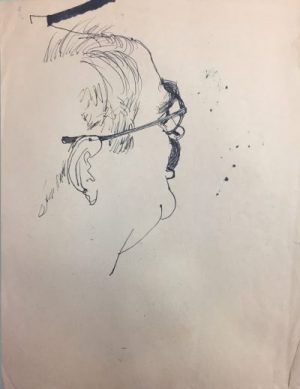 Charles Olson [FIG. 1] was a poet and a pedagogue. He began his teaching career at Clark University in the mid-1930s. In 1938, he took up a Guggenheim Fellowship in support of research on Herman Melville, leading to the publication of Call Me Ishmael. During the 1940s Olson also worked in various positions for the US Government: as Associate Chief of the Foreign Languages Division for the Office of War Information and as Foreign Nationalities Division Director for the Democratic National Committee). In the late 1940s, partly on account of his poetic debut Y & X (in collaboration with the Italian artist Corrado Cagli) and partly after a strong recommendation from Edward Dahlberg, Josef Albers invited Olson to give a series of classes on writing at Black Mountain College,[1] where he eventually took up a permanent position before becoming its rector until its closure in 1957. [FIG. 2] These academic posts were followed by others in the 1960s, initially at SUNY Buffalo and then at the University of Connecticut. Olson’s reputation as poet/theorist was secured by his seminal 1950 essay “Projective Verse”; from that point on, he wrote poems until the day he died.
Charles Olson [FIG. 1] was a poet and a pedagogue. He began his teaching career at Clark University in the mid-1930s. In 1938, he took up a Guggenheim Fellowship in support of research on Herman Melville, leading to the publication of Call Me Ishmael. During the 1940s Olson also worked in various positions for the US Government: as Associate Chief of the Foreign Languages Division for the Office of War Information and as Foreign Nationalities Division Director for the Democratic National Committee). In the late 1940s, partly on account of his poetic debut Y & X (in collaboration with the Italian artist Corrado Cagli) and partly after a strong recommendation from Edward Dahlberg, Josef Albers invited Olson to give a series of classes on writing at Black Mountain College,[1] where he eventually took up a permanent position before becoming its rector until its closure in 1957. [FIG. 2] These academic posts were followed by others in the 1960s, initially at SUNY Buffalo and then at the University of Connecticut. Olson’s reputation as poet/theorist was secured by his seminal 1950 essay “Projective Verse”; from that point on, he wrote poems until the day he died.
With that in mind, setting his poetics (the theory and practice of verse composition) in relation to his pedagogy (the theory and practice of teaching) seems an obvious thing to do. However, my project attempts something slightly more ambitious, namely to read Olson’s poetics and pedagogy as both complementary and also as coincident undertakings. 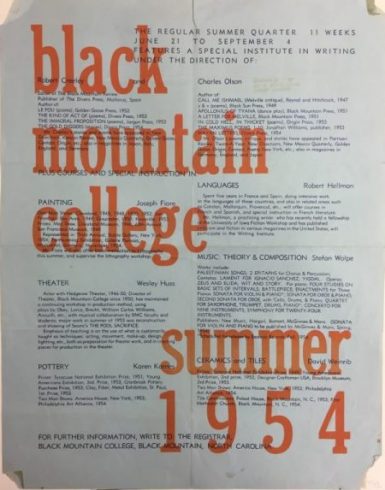 Some of Olson’s comments in the minutes of BMC faculty meetings, where the subject of conversation is how best to go about teaching, often sound exactly like his ideas concerning good writing practice and procedure; similarly, his verse is frequently didactic in tone and instructional in form. Just how Olson’s prosody can be seen to issue the reader with “instructions” is the subject of an essay I published in Contemporary Olson (Manchester UP, 2015), a work that serves as a starting point the larger project at hand. Throughout, I mean to argue that Olson’s ideas and methods of writing are identical to his ideas and methods of teaching, and to explore the consequences of that.
Some of Olson’s comments in the minutes of BMC faculty meetings, where the subject of conversation is how best to go about teaching, often sound exactly like his ideas concerning good writing practice and procedure; similarly, his verse is frequently didactic in tone and instructional in form. Just how Olson’s prosody can be seen to issue the reader with “instructions” is the subject of an essay I published in Contemporary Olson (Manchester UP, 2015), a work that serves as a starting point the larger project at hand. Throughout, I mean to argue that Olson’s ideas and methods of writing are identical to his ideas and methods of teaching, and to explore the consequences of that.
As Eleanor Berry and Alan Golding have recently suggested, Olson sought to extend “his formal concerns into the epistemological realm in arguing that projective verse involves a ‘stance towards reality’ that he labels ‘objectism’”. Olson understood “objectism”, Berry and Golding rightly note, as the “getting rid of the lyrical interference of the individual as ego”, which they describe as “an ethically anti-humanist move to take poetry beyond mere self-expression into more culturally capacious realms of statement”.[2] As a poet as well as a teacher, Olson might well have wanted to strip away all traces of the “individual as ego”, but it is not necessarily how he went about the actual business of either teaching or writing poems. Indeed, a good deal of archival material demonstrates that, in actual and historical fact, Olson’s methods are highly egoistic, often radically so (where by “egotistic” I do not mean “excessively conceited”, but rather interested in the “self” as a foundation for both practice and comportment).
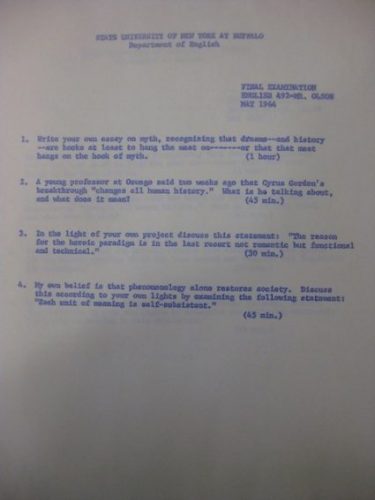 Consider, as a case in point, the exam questions he set for students taking his 1964 “Literature and Myth” course at SUNY Buffalo. Question 4 in particular, which begins “My own belief is that…”, demonstrates the extent to which Olson exerted strong control over the parameters of whatever horizons of understanding his students operated within. [FIG. 3] By all accounts, Olson was, as his long-time correspondent J. H. Prynne recently put it, “an influential and powerful teacher”; but he and his “Black Mountain team”, Prynne goes on to contend, “practised ascendency over the students and dominated their development, and offered themselves as exemplary models to be followed, not as choices to be made”.[1] This assessment is consistent with reports given by Olson’s actual students who never quite fell under his spell, such as Francine du Plessix (later Gray); likewise, Olson’s often bad tempered and downright condescending notes to Cid Corman in Letters for Origin portray an authoritative teacher who suffered dissent badly.[2] Charles Boer also reported, speaking to Olson in the second person, “your classrooms were for your ideas. If a student thought otherwise, he was soon set straight on the matter”.[3]
Consider, as a case in point, the exam questions he set for students taking his 1964 “Literature and Myth” course at SUNY Buffalo. Question 4 in particular, which begins “My own belief is that…”, demonstrates the extent to which Olson exerted strong control over the parameters of whatever horizons of understanding his students operated within. [FIG. 3] By all accounts, Olson was, as his long-time correspondent J. H. Prynne recently put it, “an influential and powerful teacher”; but he and his “Black Mountain team”, Prynne goes on to contend, “practised ascendency over the students and dominated their development, and offered themselves as exemplary models to be followed, not as choices to be made”.[1] This assessment is consistent with reports given by Olson’s actual students who never quite fell under his spell, such as Francine du Plessix (later Gray); likewise, Olson’s often bad tempered and downright condescending notes to Cid Corman in Letters for Origin portray an authoritative teacher who suffered dissent badly.[2] Charles Boer also reported, speaking to Olson in the second person, “your classrooms were for your ideas. If a student thought otherwise, he was soon set straight on the matter”.[3]
The question for me is, how to square this authoritarian streak with Olson’s anarchic, deeply anti-technocratic approaches to teaching and writing.[6] In regards to both he admonished students and burgeoning writers to practice “istorin’”, an activity he attributed to Herodotus’s historiography and defined as “finding out for yourself”. The implications of this are far too numerous to encapsulate here, but foremost amongst them is Olson’s total refusal of conventional curricula: Olson was profoundly skeptical about lesson plans and learning outcomes, all of which promised to curtail in advance any line of inquiry that organically emerged from the pedagogical process itself.[7] Several former students of Olson’s recount how he would habitually stay after class  to study the chalk board, as though trying to make sense of what had happened, what was said. In “FIELD COMPOSITION”, or “projective verse” practice, the poet “puts himself in the open—he can go by no track other than the one the poem under hand declares, for itself”.
to study the chalk board, as though trying to make sense of what had happened, what was said. In “FIELD COMPOSITION”, or “projective verse” practice, the poet “puts himself in the open—he can go by no track other than the one the poem under hand declares, for itself”.
The examinations Olson wrote for Clark University students reveal a key aspect of his pedagogical drive, namely the prioritisation of writing well over reading well. He was constantly interweaving questions of personal style, form and the like, into questions ostensibly about other texts. The idea here is that, for Olson, the most important texts were always one’s own. A headnote to a 22 January 1935 mid-year English II examination begins: “keep in mind that this is a course in writing. Clarity, accuracy, even beauty of expression is expected. No paper carelessly written will be considered satisfactory, in spite of content”.[8] [FIG. 4]
What exactly to make of all this I have yet to rightly determine, and giving a good answer will be the aim of my work over the next couple of years. But the plan is to conceptualise and then critique Olson’s pedagogy as poetics, and visa versa. What is clear, however, from the two weeks I was able to spend exploring and working in this extensive archive—a task made all the more challenging by Olson’s increasingly illegible handwriting and his tendency to write with dull pencils on acidic paper or the backs of dirty envelopes—have proven invaluable in terms of grounding a rather abstract idea in the hard facts of archival materials. For instance, the Charles Olson Research Collection holds large numbers of documents categorised as “prose”, which, upon inspection, are clearly notes for lectures or seminars given (mostly) at Black Mountain College. Though not a systematic thinker, not by a long shot, Olson, in many of these documents especially, is forever attempting to enumerate and order his thoughts on myth, on writing and on history. In  others, such one that “begins” (if it can be said to begin anywhere) “You can’t use words as ideas”, Olson’s writing is (dis)organised spatially, composed quite literally “by field”, that is to say, in different intersected planes of the page space. [FIG. 5]
others, such one that “begins” (if it can be said to begin anywhere) “You can’t use words as ideas”, Olson’s writing is (dis)organised spatially, composed quite literally “by field”, that is to say, in different intersected planes of the page space. [FIG. 5]
The archive also contains a great bulk of correspondence, written both by Olson, especially in his capacity as Rector of Black Mountain College, and by hundreds of correspondents, many of whom either taught with Olson (such as Robert Duncan and Robert Creeley) or were taught by him (such as Dorn, Dawson and Wieners). These letters have an obvious historical importance, given the established reputations of Olson’s peers. Of equal if rather different interest are letters Olson wrote to and received from lesser known interlocutors: officers at funding bodies, benefactors, university administrators, invitees to BMC’s summer “institutes” programme and parents of students. I expect many of these to feature significantly in my completed work. Naturally the manuscripts and other pre-publication material of the poetry—those pertaining to The Maximus Poems particularly—will feature throughout my work as well. The first drafts of Olson’s poems, written mostly in longhand and sometimes to spectacular effect [FIG. 6], demand readers reassess the value and importance of the typewriter to this work. But it’s the less glamorous reaches of the archive that have thrown up the most interesting preliminary findings.
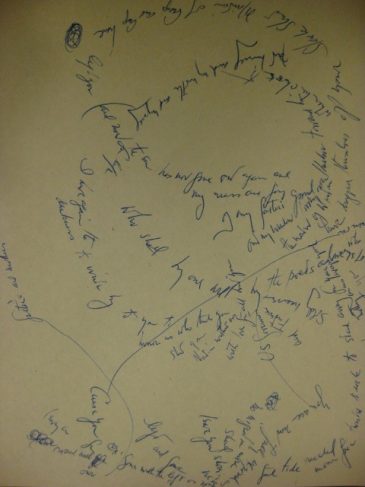
– Michael Kindellan
Sheffield, March 2017
Figures:
- Fielding Dawson Drawing of Charles Olson (ink on paper), Fielding Dawson Papers. Archives & Special Collections at the Thomas J. Dodd Research Center, University of Connecticut Libraries.
- Black Mountain Ephemera, Fielding Dawson Papers. Archives & Special Collections at the Thomas J. Dodd Research Center, University of Connecticut Libraries.
- Series III, Box 268. Charles Olson Research Collection. Archives & Special Collections at the Thomas J. Dodd Research Center, University of Connecticut Libraries.
- Series III, Box 259. Charles Olson Research Collection. Archives & Special Collections at the Thomas J. Dodd Research Center, University of Connecticut Libraries.
- Series I, Box 26. Charles Olson Research Collection. Archives & Special Collections at the Thomas J. Dodd Research Center, University of Connecticut Libraries.
- Series I, Box 5, Folder 273. “I have been an ability—a machine”. Charles Olson Research Collection. Archives & Special Collections at the Thomas J. Dodd Research Center, University of Connecticut Libraries.
Notes:
[1] Josef Albers, 24 September 1948 Letter to Charles Olson, Series II Box 124, Charles Olson Research Collection. Archives & Special Collections at the Thomas J. Dodd Research Center, University of Connecticut Libraries.
[2] Eleanor Berry and Alan Golding, “Projective Verse”, The Princeton Encyclopedia of Poetry and Poetics, 4th ed., ed. Roland Greene et al, (Princeton: Princeton University Press, 2012), 1109.
[3] J. H. Prynne, “The Art of Poetry No. 101”, The Paris Review 218 (Fall 2016): 183.
[4] Charles Olson, Letters for Origin: 1950-1956, ed. Albert Glover (London: Cape Goliard, 1969).
[5] Charles Boer, Charles Olson in Connecticut (Chicago: Swallow Press, 1975), 54.
[6] As Martin Duberman reports, John Cage esteemed Olson’s Black Mountain College a truly anarchic community, in contradistinction to Josef Albers’s, where the “anarchic feeling… was only on the surface”. Martin Duberman, Black Mountain College: An Exploration in Community (Evanston: Northwestern University Press, 1972), 367.
[7] Cf. Olson’s statements on the matter in “Minutes of a Meeting of the Black Mountain College Faculty, 1951”, Olson: The Journal of the Charles Olson Archives 2 (Fall 1974): 16-24.
[8] Charles Olson, “Clark University English II Mid-Year Examination, Series III Box 258, Charles Olson Research Collection. Archives & Special Collections at the Thomas J. Dodd Research Center, University of Connecticut Libraries.

